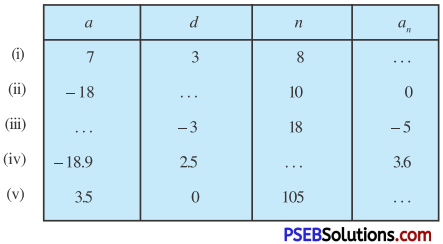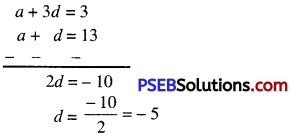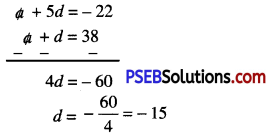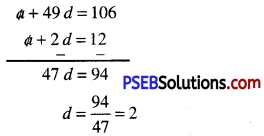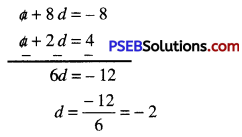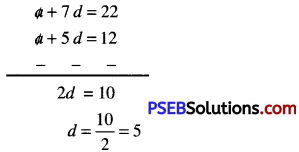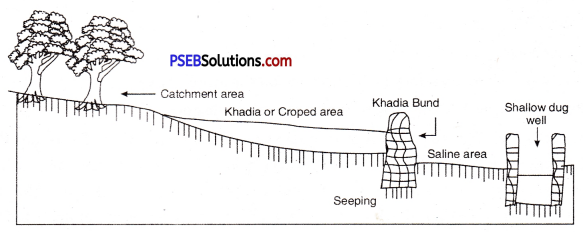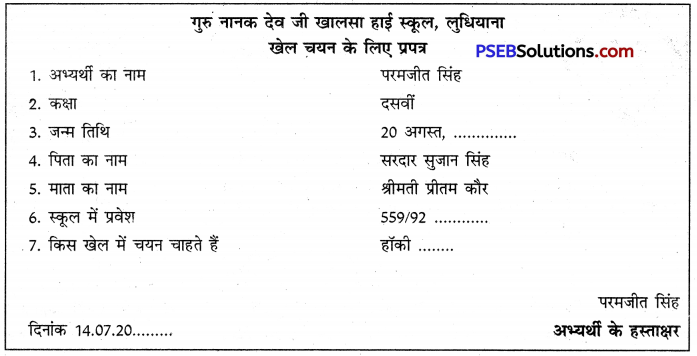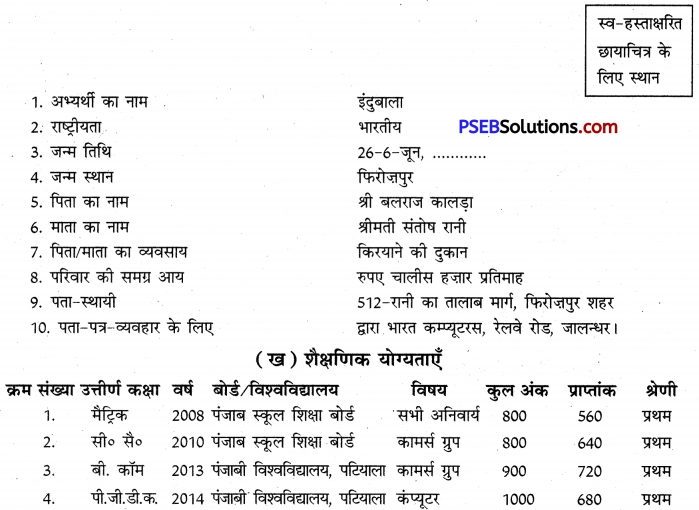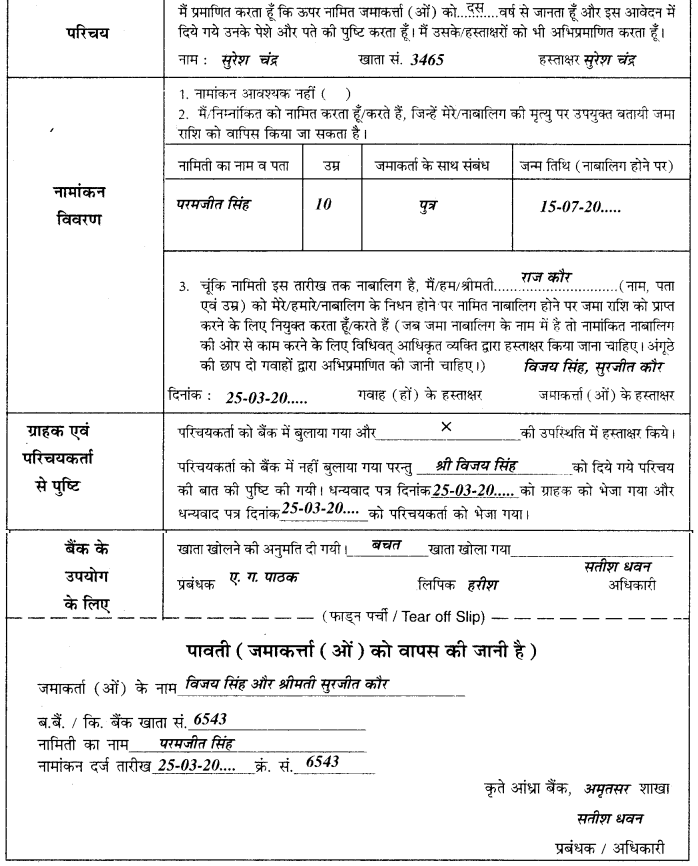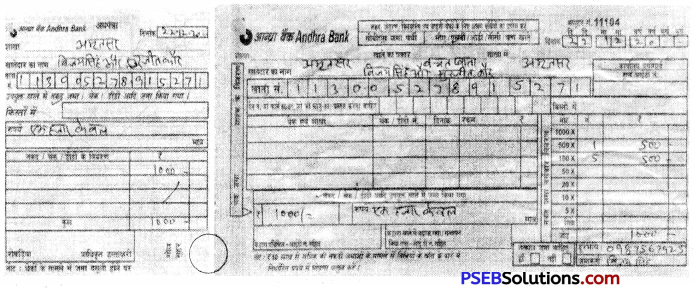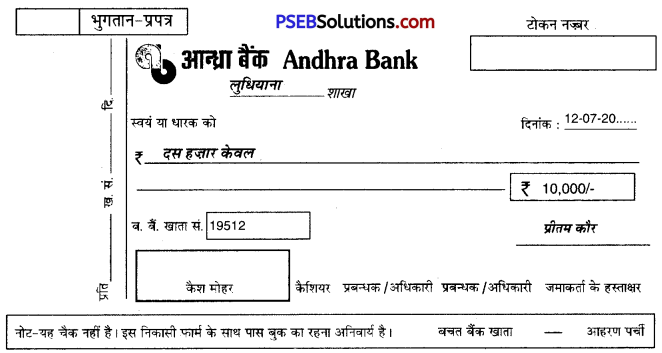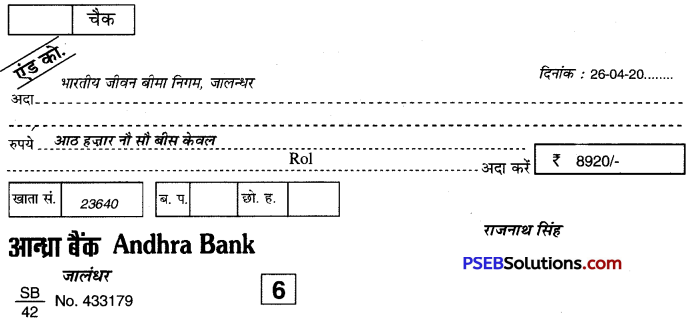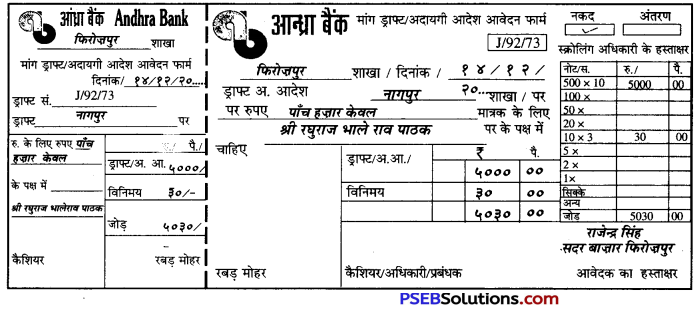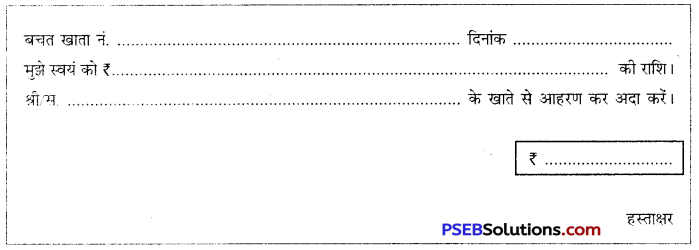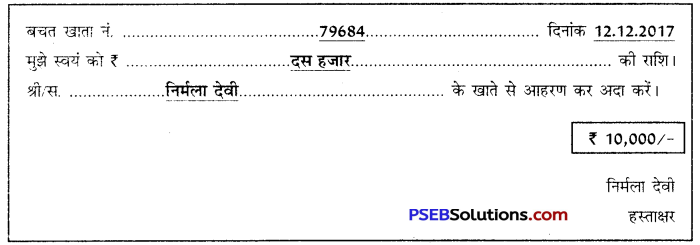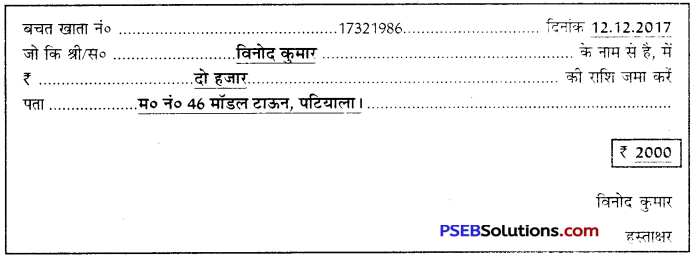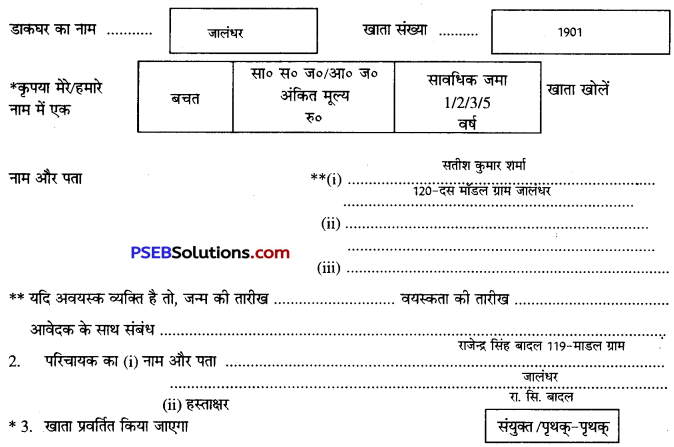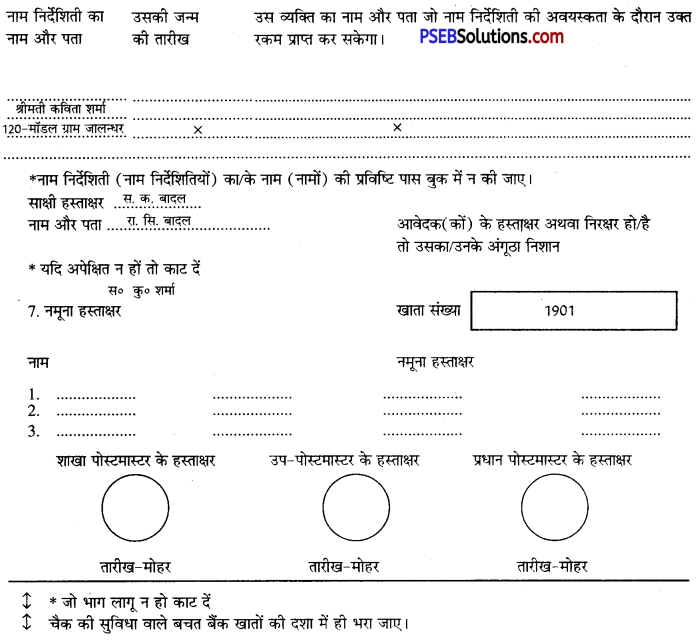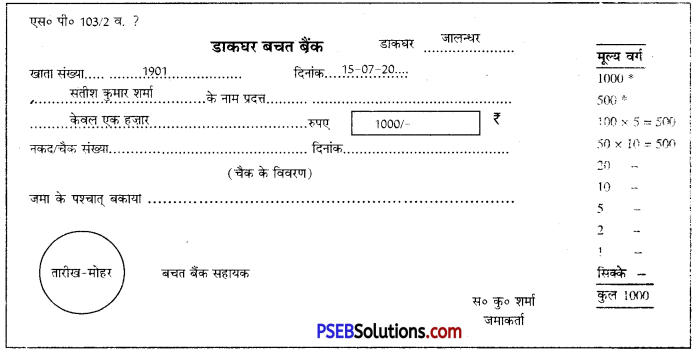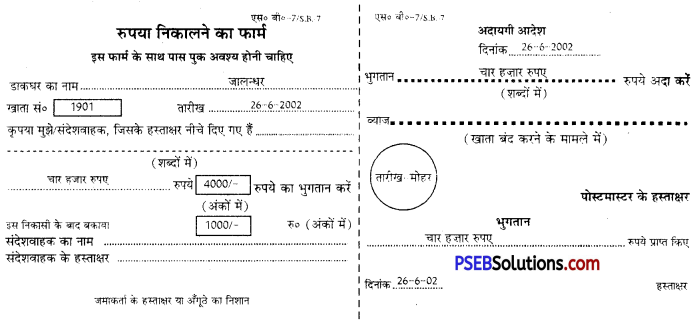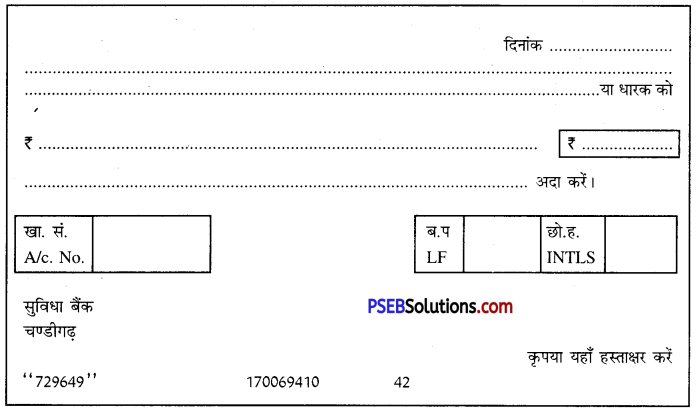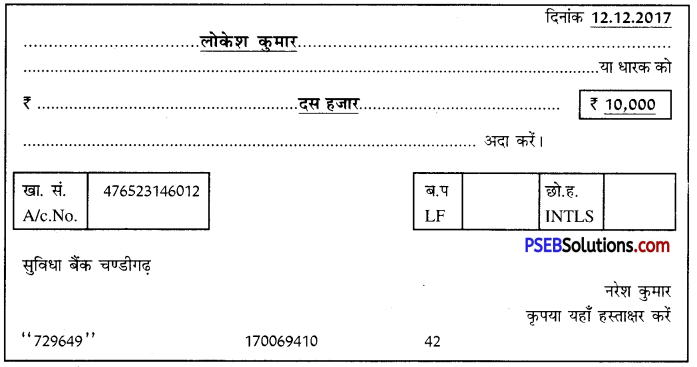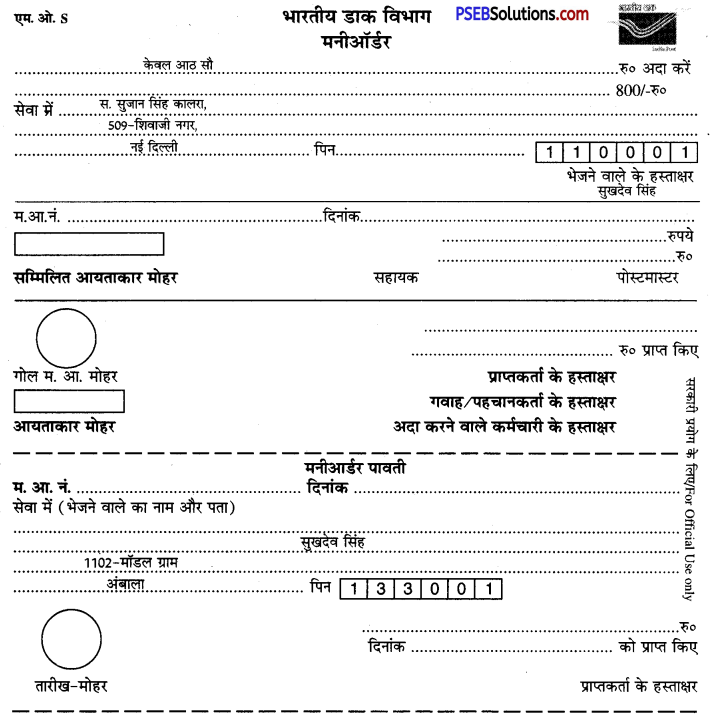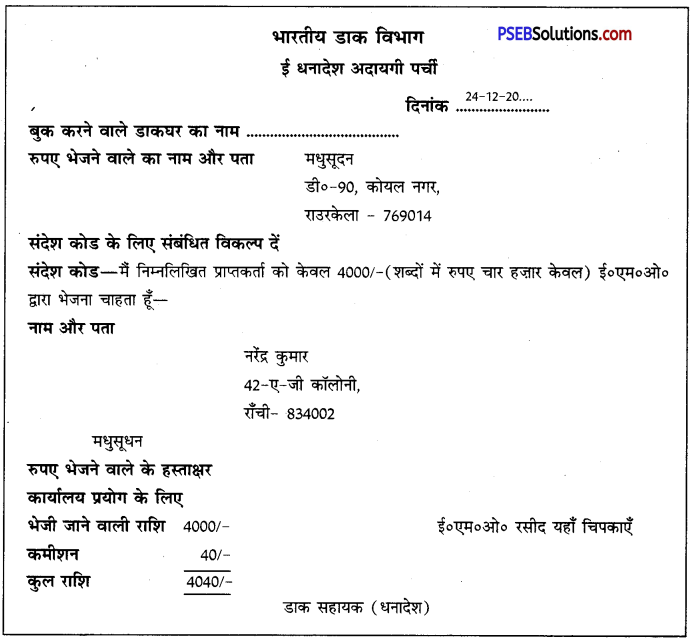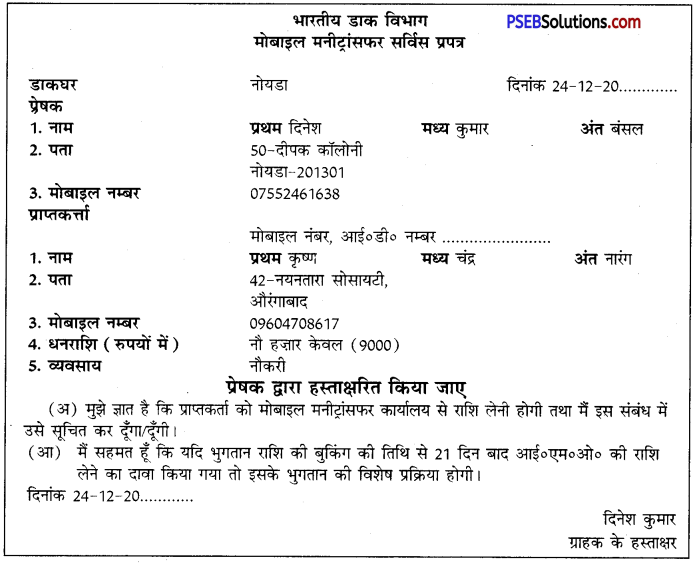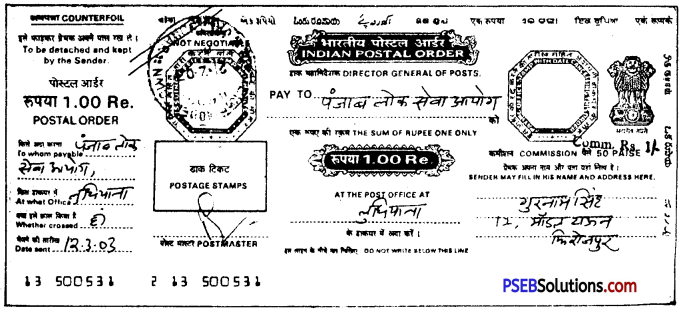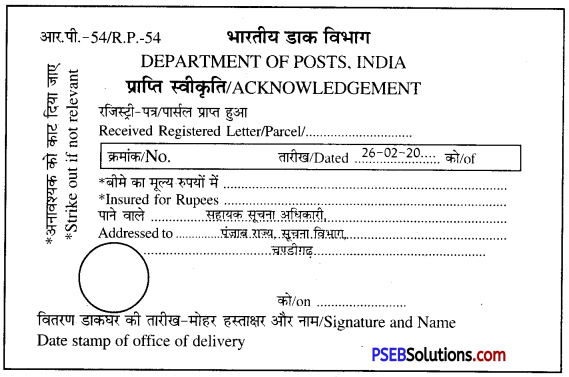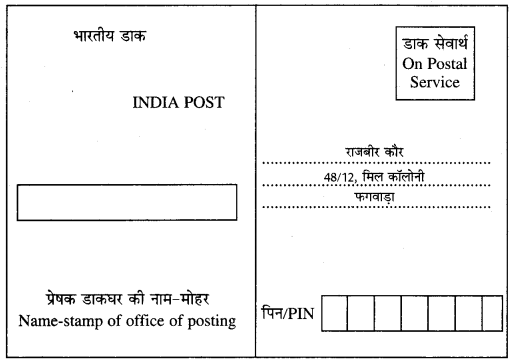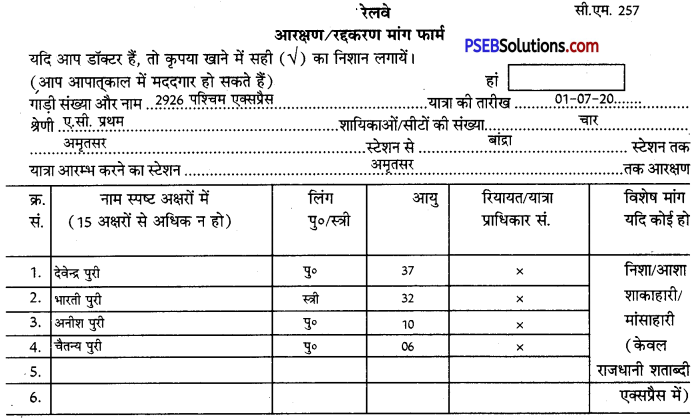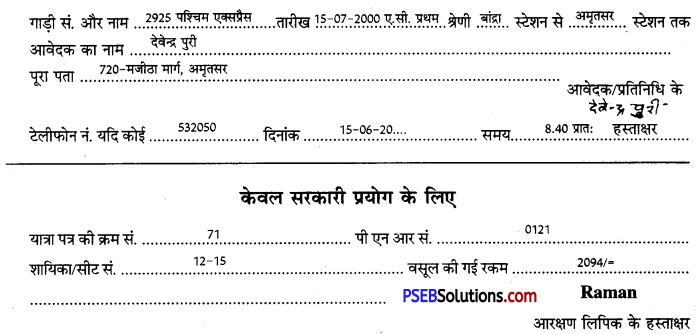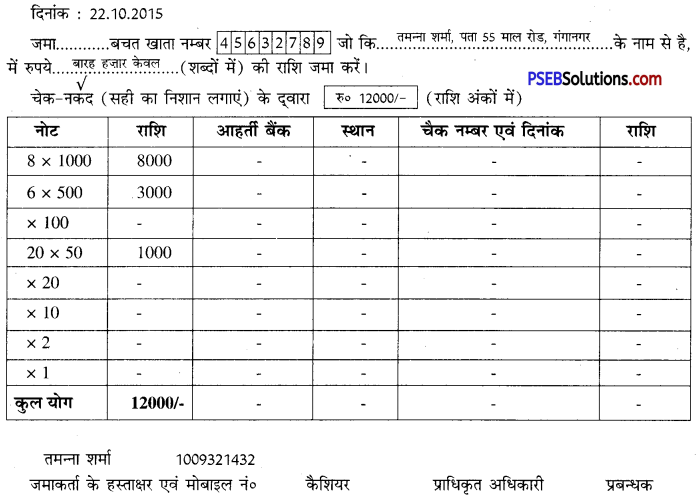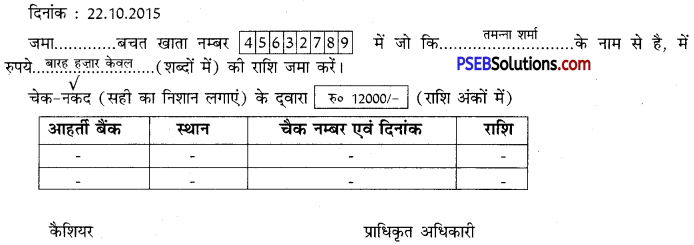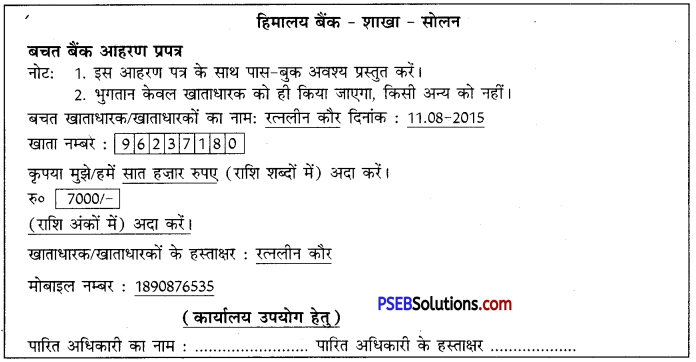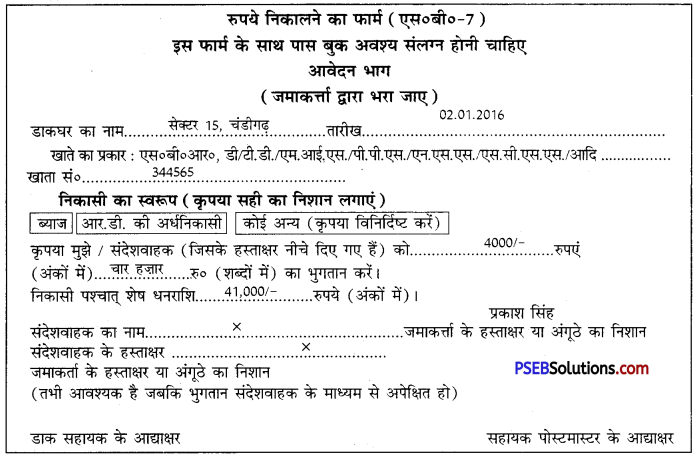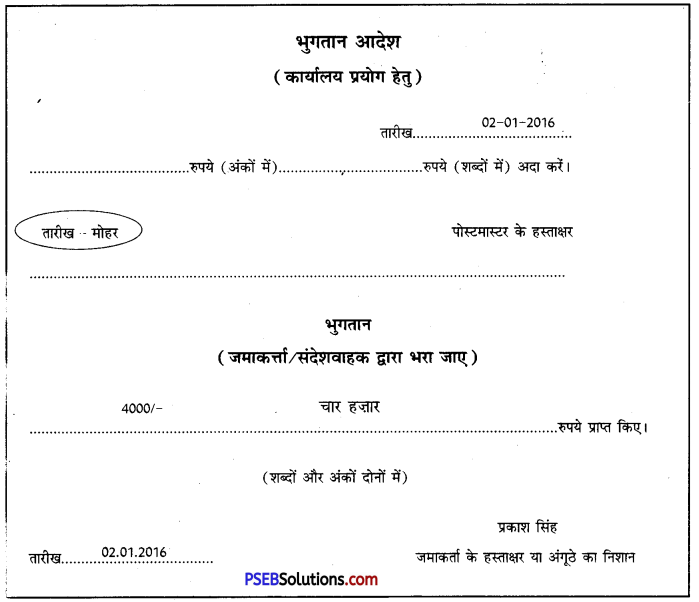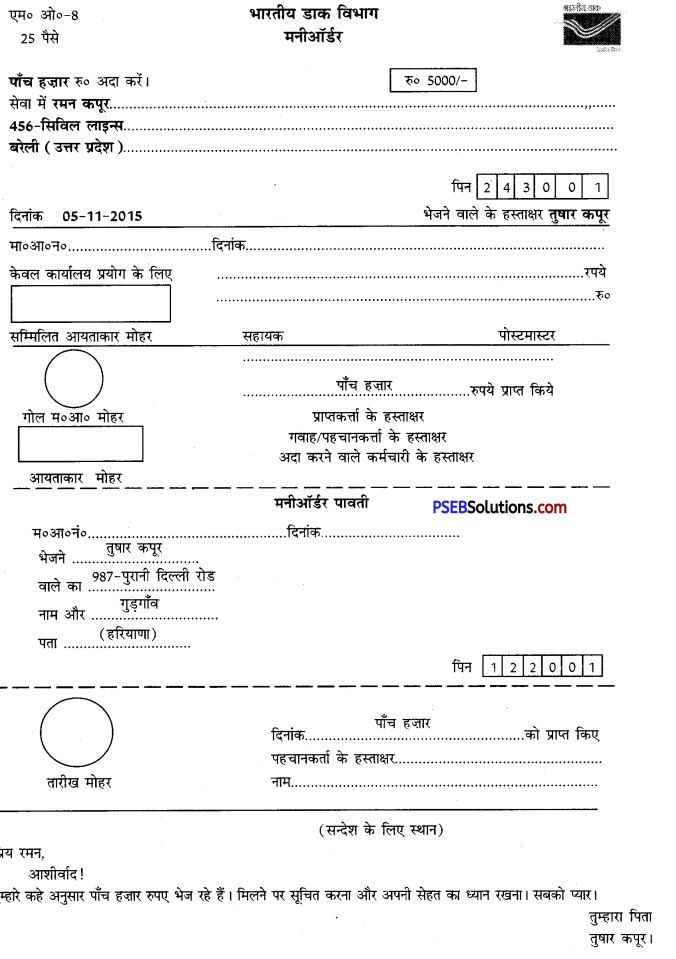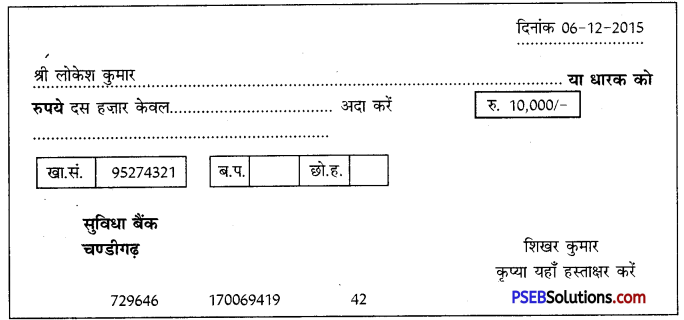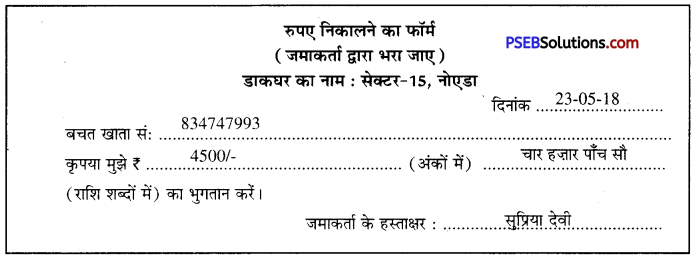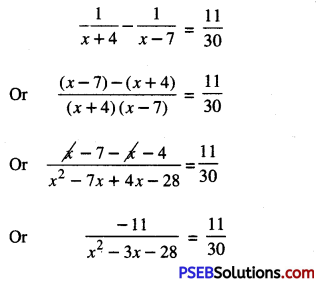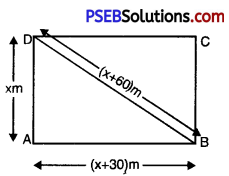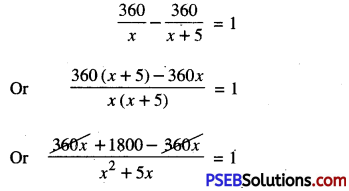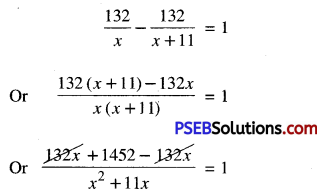Punjab State Board PSEB 10th Class Hindi Book Solutions Hindi Grammar vigyapan suchana aur prativedan विज्ञापन, सूचना और प्रतिवेदन Exercise Questions and Answers, Notes.
PSEB 10th Class Hindi Grammar विज्ञापन, सूचना और प्रतिवेदन
I. विज्ञापन
प्रश्न 1.
विज्ञापन किस प्रकार की कला है?
उत्तर:
विज्ञापन किसी जानकारी को प्रदान करने की एक सशक्त और प्रभावशाली कला है।
प्रश्न 2.
क्या विज्ञापन व्यक्तिगत होता है?
उत्तर:
विज्ञापन व्यक्तिगत नहीं होता क्योंकि इसका सीधा संबंध वस्तु विशेष से होता है।

प्रश्न 3.
व्यापारिक क्षेत्र में विज्ञापन के मुख्य तीन उद्देश्य कौन-से हैं?
उत्तर:
- मांग उत्पन्न करना
- मांग बनाए रखना
- मांग की वृद्धि करना।
प्रश्न 4.
विज्ञापन व्यवसाय को क्या बनाते हैं?
उत्तर:
विज्ञापन व्यवसाय को सर्वांगमुखी बनाते हैं।
प्रश्न 5.
विज्ञापन किन-किन चीज़ों के होते हैं?
उत्तर:
विज्ञापन व्यक्ति के गुणों, अनुभवों, उत्पादित वस्तु आदि के होते हैं।
प्रश्न 6.
विज्ञापन का सर्वाधिक जन-सुलभ माध्यम कौन-सा है?
उत्तर:
विज्ञापन का सर्वाधिक जन-सुलभ माध्यम समाचार-पत्र है।
प्रश्न 7.
‘विज्ञान’ शब्द कैसे बना है?
उत्तर:
विज्ञान शब्द ‘वि’ उपसर्ग और ‘ज्ञापन’ शब्द से बना है।
प्रश्न 8.
विज्ञापन का मुख्य उद्देश्य क्या है?
उत्तर:
विज्ञापन का मुख्य उद्देश्य वस्तु, व्यक्ति आदि की जानकारी देना होता है।
प्रश्न 9.
विज्ञापन किसे कहते हैं?
उत्तर:
विज्ञापन जनसंपर्क का वह माध्यम है जो व्यापारिक क्षेत्र को समुचित रूप से विकसित करने की क्षमता रखता है। विज्ञापन व्यक्तिगत नहीं होता क्योंकि इसका सीधा संबंध वस्तु विशेष से होता है और वस्तु का संबंध औद्योगिक संस्था से रहता है।
प्रश्न 10.
प्राय: विज्ञापन किन रूपों में देखने को मिलते हैं?
उत्तर:
प्रायः विज्ञापन तीन रूपों में देखने को मिलते हैं-
- पत्र-पत्रिकाएं-पत्र-पत्रिकाओं में हम अक्सर विभिन्न प्रकार के विज्ञापनों को पढ़ते हैं उन विज्ञापनों को देखकर हमारे विचारों में बदलाव आता है।
- बाह्य विज्ञापन- इस प्रकार के विज्ञापन हमें पोस्टर, होर्डिंग, पंफलेट आदि में देखने को मिलते हैं। (ii) अन्य साधन-विज्ञापन के अन्य साधनों में रेडियो, टेलीविज़न, सिनेमा आदि को रखा जा सकता है।
प्रश्न 11.
विज्ञापन का मुख्य उद्देश्य क्या है?
उत्तर:
विज्ञापन का मुख्य उद्देश्य उपभोक्ता को उत्पाद एवं उत्पादक की जानकारी देना है। वह उत्पादित वस्तु के रूप, गुण, मूल्य आदि की जानकारी एवं सूचना आकर्षक ढंग से प्रदान करता है, जिससे उपभोक्ता में उस वस्तु को खरीदने की इच्छा जागृत हो उठती है। यह उत्पादक और उपभोक्ता के बीच मधुर संबंधों को भी स्थापित करता है। इसका उद्देश्य विज्ञापन देने वाली संस्था के नाम की प्रसिद्धि करना तथा उसकी ख्याति को बढ़ाना भी होता है। मांग उत्पन्न करना और मांग में वृद्धि करना ही विज्ञापन का उद्देश्य है।
प्रश्न 12.
पहले और आज के समय में विज्ञापन में क्या अंतर आया है?
उत्तर:
पहले के समय में विज्ञापन का अर्थ मात्र सूचना देने तक का होता था, किन्तु आज इसका अर्थ अत्यंत व्यापक हो गया है। आज का युग विज्ञापनमय हो गया है। आज विज्ञापन एक सीमित साधन न होकर अत्यंत विस्तृत हो गया है। आज विज्ञापन एक कला के रूप में मुखरित हो चुका है। इसके द्वारा उत्पादक उत्पादन के रूप, गुण, मूल्य आदि की पूरी सूचना आकर्षक ढंग से प्रदान करता है, जिससे उपभोक्ता में उस वस्तु को खरीदने की इच्छा जागृत हो उठती है। आज विज्ञापन केवल उत्पादन की वृद्धि में ही सहायता नहीं देते, बल्कि प्रतिस्पर्धा की क्षमता बढ़ा कर मूल्यों को स्थिरता भी प्रदान करती है।
प्रश्न 13.
वर्तमान युग में विज्ञापन का कार्य कैसे सरल हो गया है?
उत्तर:
विज्ञापन आधुनिक युग में बहुत बड़ी व्यापारिक शक्ति है जो वस्तुओं को बेचने में अनुपम सहायता करती है। ऐसे में ऋण की सुविधा ने विज्ञापन के कार्य को और भी अधिक सरल बना दिया है। उत्पादक, डीलर, दुकानदार आदि सभी किसी न किसी बैंक या ऋण देने वाली कंपनियों से उपभोक्ता को ऋण दिला देते हैं और वस्तु को बेच देते हैं। कभी-कभी तो एक रुपया देकर शेष बची धनराशि किश्तों में अदा की जाती है। अत: स्पष्ट है कि ऋण की सुविधा ने विज्ञापन का कार्य सरल से सरलतम बना दिया है।
प्रश्न 14.
वर्तमान युग विज्ञापन का युग है। सिद्ध कीजिए।
उत्तर:
आज का युग विज्ञापन अथवा प्रचार का युग है। जिसका अधिक प्रचार अथवा विज्ञापन हो जाएगा वही वस्तु एवं व्यक्ति सर्वत्र लोकप्रिय हो जाता है बच्चे-बच्चे के मुख से लोकप्रिय विज्ञापनों के शब्द सुने जा सकते हैं। बच्चे क्या बड़े भी उसी उत्पाद को लेना चाहते हैं जिसका विज्ञापन आकर्षक हो। दंत मंजन से लेकर दुल्हन की साड़ी, कपड़े धोने के साबुन से लेकर दर्द निवारक दवा तक विज्ञापन के आधार पर बिक रहे हैं। यही कारण है कि आज का व्यापार विज्ञापन की शक्ति पर निर्भर हो गया है। प्रत्येक व्यापारी अपने उत्पाद को उपभोक्ता तक पहुंचाने के विज्ञापन का आश्रय लेता है। अतः स्पष्ट है कि वर्तमान युग विज्ञापन का युग है।
प्रश्न 15.
व्यक्ति के जीवन में विज्ञापन का क्या महत्त्व है?
उत्तर:
आज व्यक्ति का जीवन विज्ञापनमय हो गया है। विज्ञापन उपभोक्ताओं की सेवा करता है। उन्हें जहां वह नवीन वस्तुओं की जानकारी देता है। वहीं उन्हें उचित दाम पर माल भी दिलाता है। नई-नई वस्तुओं के गुण, उपयोग और मूल्यों की जानकारी से उपभोक्ताओं को पारिवारिक बजट बनाने में सहायता मिलती है। उनका रहन-सहन का स्तर भी बढ़ता जाता है। इससे अनेक लोगों को रोज़गार भी प्राप्त होता है। सेल काऊंटरों पर स्त्री-पुरुषों की बड़ी भीड़ का जमाव इन्हीं के कारण होता है।
प्रश्न 16.
विज्ञापन केवल व्यापारिक अनिवार्यता नहीं है, बल्कि सभी क्षेत्रों में है। सिद्ध कीजिए।
उत्तर:
विज्ञापन केवल व्यापारिक अनिवार्यता ही नहीं है, बल्कि राजनीतिक, सामाजिक, धार्मिक तथा जीवन के अन्य क्षेत्रों में भी यह अपनी उपयोगिता सिद्ध कर चुका है। लोकतंत्रीय व्यवस्था की तो यह जान है। विज्ञापन के बिना लोकतंत्रीय पद्धति सफलता प्राप्त नहीं कर सकती। विभिन्न राजनीतिक दल अपने सिद्धांतों, कार्यक्रमों इत्यादि के संबंध में जनसाधारण को विज्ञापनों के द्वारा ही जानकारी प्रदान करते हैं। धार्मिक नेता भी विज्ञापन का पूरा सहारा लेते हैं। धार्मिक स्थानों पर किए जाने वाले पूजा-पाठ की फिल्म स्लाइडें सिनेमा गृहों में दिखाई जाती हैं। रंग-बिरंगे बड़े-बड़े पोस्टर लगाए जाते हैं। लाऊड-स्पीकर पर प्रवचन तथा नेताओं की घोषणाएं अक्सर सुनी जाती हैं।

प्रश्न 17.
विज्ञापन को तैयार करते समय किन-किन बातों का ध्यान रखना चाहिए?
उत्तर:
आज का युग विज्ञापन का युग है। अब किसी भी व्यापार की सफलता विज्ञापन पर निर्भर करती है। इसलिए विज्ञापन की भाषा सदा वही होनी चाहिए जिस क्षेत्र में उसका प्रचार हो रहा हो। विज्ञापन को तैयार करते समय निम्नलिखित बातों का ध्यान रखना आवश्यक है-
(i) आकर्षण-किसी भी विज्ञापन का पहला गुण उसका आकर्षक लगना होता है। सुंदर-रंगीन एवं आकर्षक चित्रों से सजे विज्ञापन उपभोक्ता को अपनी ओर शीघ्रता से खींच लेते हैं।
(ii) संक्षिप्तता-एक अच्छा सटीक एवं उपयुक्त विज्ञापन बनाते समय उसकी संक्षिप्तता पर विशेष ध्यान देना चाहिए। संक्षिप्त विज्ञापन सरलता से समझ में आ जाता है। खर्च भी कम पड़ता है।
(iii) सरल-सरस भाषा-विज्ञापन बनाते एवं लिखते समय भाषा का बहुत अधिक महत्त्व होता है। विज्ञापन की भाषा क्षेत्र की भाषा के अनुकूल होनी चाहिए। भाषा में सरल एवं सरस शब्दों का प्रयोग होना चाहिए। भाषा ही विज्ञापन की जान होती है। नारा लेखन, शीर्षक आदि में इसका विशेष महत्त्व है।
(iv) माध्यम-विज्ञापन को तैयार करते समय इसके माध्यम का चुनाव बड़ी ही सजगता से करना चाहिए। विभिन्न वस्तुओं के रूप, गुण, मूल्य आदि की जानकारी देने के लिए माध्यम का चुनाव अत्यंत आवश्यक है क्योंकि सही या ग़लत माध्यम के चुनाव से विज्ञापन सफल या असफल हो सकता है। विज्ञापन के तीन माध्यम हैं-
- पत्र-पत्रिकाएं
- बाह्य विज्ञापन-पोस्टर, पंफलेट, होर्डिंग आदि।
- अन्य साधन-रोडियो, टेलीविज़न, सिनेमा आदि।
(v) स्पष्टता-विज्ञापन लिखते समय अमूक जानकारी को स्पष्ट रूप से लिखा जाना चाहिए। फिर चाहे वह वस्तु की गुणवत्ता हो या फिर विज्ञापन देने वाले का पता ही सब कुछ साफ-साफ स्पष्ट रूप से लिखा होना चाहिए।
(vi) छलकपट से रहित-विज्ञापन सदैव छल-कपट से रहित होना चाहिए। धोखे तथा जालसाजी से उपभोक्ता वस्तु एक बार तो ले लेता है किंतु दोबारा कभी उस ओर मुंह नहीं करता। बाज़ार में विश्वास बनाना कठिन कार्य है जबकि विश्वास तोड़ना क्षण-भर का काम है। अतः विज्ञापन सदैव छल-कपट से पूरी तरह रहित होना चाहिए।
(vii) स्मरणीयता-विज्ञापन को लिखते समय उसकी स्मरणीयता पर विशेष ध्यान रखना चाहिए। एक अच्छा विज्ञापन वही है जो लोगों को शीघ्रता से स्मरण हो जाए जैसे रुकावट के लिए खेद है। आज नगद कल उधार। निष्कर्ष- स्पष्ट है कि विज्ञापन सरल भाषा में रचा गया प्रभावशाली एवं आकर्षक होना चाहिए जो ग्राहक को वस्तु लेने के लिए विवश कर दे।
प्रश्न 18.
विज्ञापन के विभिन्न माध्यमों अथवा साधनों का विस्तार से वर्णन कीजिए।
उत्तर:
सामान्य रूप से विज्ञापन का अर्थ ‘विशेष सूचना या जानकारी’ देना है। यह जानकारी उत्पादक उपभोक्ता को देता है। वह उत्पादित वस्तु के रूप, गुण, उपादेयता, मूल्य आदि की पूरी सूचना आकर्षक ढंग से प्रदान करता है जिससे उपभोक्ता को उस वस्तु को खरीदने की इच्छा जागृत हो उठती है। व्यापारिक क्षेत्र को समुचित रूप से विकसित करने के लिए विज्ञापन के निम्नलिखित माध्यमों एवं साधनों का प्रयोग किया जाता है-
(i) घर-घर जाकर-विज्ञापन का सबसे पुराना साधन एवं माध्यम घर-घर जाकर वस्तु की विशेषताओं से लोगों को परिचित कराना है। इस माध्यम में कंपनियां अपने एजेंट लोगों के बीच भेजते हैं जो घर-घर जाकर वस्तु की गुणवत्ता को लोगों तक पहुंचाते हैं। ये लोग घर-घर जाकर सामान भी बेचते हैं। उसका आर्डर भी लेते हैं।
(ii) ढिंढोरा पीटकर-प्राचीन समय में ढोल, ड्रम आदि को पीट-पीटकर मुनादी करवाई जाती थी। उसे ही ढिंढोरा पीटना कहते हैं। आज वही रिक्शा, आटो रिक्शा, रेहड़ी, टैम्पू आदि के माध्मय से किया जाता है। आज भी गांव में इसका चलन देखने को मिलता है।
(iii) रेडियो, टेलीविज़न तथा सिनेमा-आधुनिक युग में रेडियो, टेलीविज़न तथा सिनेमा श्रव्यदृश्य माध्यम के अंतर्गत आते हैं। नर-नारी तथा वाह्य यंत्रों की मिली-जुली आवाज़ दूर से सही-संभावित उपभोक्ता को अपनी ओर आकर्षित करने का गुण रखती है। छोटी-छोटी विज्ञापन फिल्मों की भरमार है।
(iv) पोस्टर, होर्डिंग, पंफलेट-पोस्टर, होर्डिंग, पंफलेट आदि को बाह्य विज्ञापनों की श्रेणी में रखा जाता है। इनका प्रदर्शन सार्वजनिक स्थानों पर किया जाता है। सुंदर-रंगीन एवं आकर्षक चित्रों से सजे विज्ञापनों को सड़कों, चौराहों आदि पर कहीं भी देखा जा सकता है। यद्यपि यह माध्यम महंगा है पर फिर भी इसका प्रचलन बहुत तेजी से बढ़ रहा है। दीवारों पर लेखन, इश्तिहार, छोटे-बड़े प्रपत्र एवं पंफलेट इसी माध्यम के अंतर्गत आते हैं।
(v) पत्र-पत्रिकाएं-पत्र-पत्रिकाएं अन्य माध्यमों की अपेक्षा अधिक लोकप्रिय तथा जन-सुलभ माध्यम है। इनका प्रचार विश्वव्यापी है। इसलिए किसी एक स्थान की वस्तु का प्रचार पूरे विश्व में संभव हो सकता है। सरकारी और गैरसरकारी स्तर पर छपी सभी पत्र-पत्रिकाओं में विज्ञापन अनिवार्य रूप में छपे रहते हैं। इनसे प्राप्त आय के द्वारा पत्रिका का प्रकाशन सरलता से किया जा सकता है। समाचार-पत्र तो विज्ञापन का प्रचार का सीधा और सबसे सरल साधन है। यह लोकप्रिय और आसान माध्यम है।
(vi) स्टॉल लगाकर-आजकल उत्पाद को सड़कों के किनारे स्टॉल लगाकर बेचने का भी प्रचलन हो चुका है। कंपनी के कर्मचारी आवाज़ लगाकर या बोर्ड आदि दिखाकर स्टॉल पर लोगों को आने के लिए आकर्षित करते हैं। वे अपने सामान की नुमाइश एवं प्रदर्शन करते हैं।
(vii) वाहनों पर पोस्टर चिपकाकर-कुछ कंपनियां बस, ट्रक, कार आदि के पीछे अपने उत्पाद के प्रभावशाली पोस्टर चिपकाती हैं। यह उनकी बिक्री को बढ़ाने का काम करता है।
(vii) मोबाइल और इंटरनेट द्वारा-विज्ञापन के सशक्त साधनों में आज मोबाइल और इंटरनेट ने अपना विशेष स्थान बना रखा है। यह वस्तु के क्रय-विक्रय का एक साधन बन चुका है। युवा पीढ़ी इसका सर्वाधिक प्रयोग कर रही
है।
(ix) डाक द्वारा-आधुनिक युग में डाक द्वारा भी विज्ञापन का प्रसार किया जा रहा है। संस्थाएं एवं कपनियां अपने उत्पादन की सूची एवं विवरणिका डाक द्वारा भेज कर लोगों को अपने उत्पाद से परिचित कराती हैं।
निष्कर्ष-निष्कर्ष रूप में कह सकते हैं कि आज विज्ञापन वस्तु को बेचने तथा लोकप्रिय बनाने में महत्त्वपूर्ण भूमिका निभा रहे हैं। विज्ञापन के अभाव में वस्तु का लोकप्रिय और अधिक मात्रा में बिकना असंभव-सा जान पड़ता है। विज्ञापन के उक्त माध्यमों का प्रयोग कर वस्तु के क्रय-विक्रय की गति को तेजी से बढ़ाया जा सकता है।
विज्ञापन के उदाहरण
प्रश्न 1.
आप विवेकानंद पब्लिक स्कूल, सैक्टर-32, चण्डीगढ़ के प्राचार्य हैं। विद्यालय की बस हेतु एक अनुभवी ड्राइवर की आवश्यकता है। वर्गीकृत विज्ञापन का प्रारूप तैयार कीजिए।
उत्तर:
ड्राइवर की आवश्यकता है।
विद्यालय की बस के लिए एक अनुभवी ड्राइवर की आवश्यकता है। आयु 55 वर्ष से अधिक न हो। बस चलाने का कम-से-कम दस वर्षों का अनुभव हो। घर का पक्का पता, स्वयं की चार तस्वीरें तथा ड्राइविंग लाइसेंस के साथ एक सप्ताह के अंदर विद्यालय में मिलें।
प्राचार्य
विवेकानंद पब्लिक स्कूल, सैक्टर-32, चण्डीगढ़।
प्रश्न 2.
आपको अपने मकान नं0 452 सैक्टर-31, चंडीगढ़ के बगीचे के रख-रखाव के लिए माली की आवश्यकता है। उस हेतु एक वर्गीकृत विज्ञापन का प्रारूप तैयार कीजिए।
उत्तर:
माली की आवश्यकता है।
बगीचे की रख-रखाव तथा देखभाल के लिए एक कुशल एवं अनुभवी माली की आवश्यकता है। चार दिन के अंदर संपर्क करें। मकान नं0 452 सैक्टर-31, चंडीगढ़। मोबाइल नं0 94666-66666

प्रश्न 3.
सरकारी सीनियर सैकेंडरी स्कूल, करनाल में आगामी सत्र के लिए छठी कक्षा से बारहवीं कक्षा तक के बच्चों के दाखिले का विज्ञापन विद्यालय के प्राचार्य की ओर से तैयार कीजिए।
उत्तर:
स्कूल में दाखिले संबंधी विज्ञापन
सरकारी सीनियर सैकेंडरी स्कूल, करनाल में आगामी सत्र हेतु छठी से बारहवीं कक्षा के दाखिले प्रारम्भ हो गए हैं। विद्यालय में शिक्षा के तीन माध्यम पंजाबी, हिंदी, अंग्रेज़ी उपलब्ध हैं। प्रतिभावान एवं ग़रीब बच्चों के लिए शिक्षा के विशेष अवसर एवं व्यवस्था हैं। कंप्यूटर एवं खेलकूद की सुविधाओं का उचित प्रबंध है। विवेक कुमार, प्राचार्य, मोबाइल नं० 89250-00000
प्रश्न 4.
आपका नाम रोहित शर्मा है। आपके कोचिंग सैंटर का नाम सरस्वती कोचिंग सेंटर है। आपका मोबाइल नं0 9416…….. है। आपने अम्बाला शहर में इंजीनियरिंग और मैडिकल की प्रवेश परीक्षाओं की कोचिंग हेतु नया कोचिंग सेंटर खोला है। कोचिंग सेंटर के उद्घाटन के संदर्भ में एक विज्ञापन लिखिए।
उत्तर:
सरस्वती कोचिंग सेंटर
01.04.20….. से इंजीनियरिंग और मैडिकल की प्रवेश परीक्षाओं की तैयारी हेतु कोचिंग क्लास शुरू हो रही है। नए विद्यार्थियों के लिए पढ़ने और पढ़ाने की विशेष व्यवस्था है। 90% से अधिक अंक पाने वाले विद्यार्थियों को उनकी फीस में 80% छूट दी जाएगी। आने-जाने के लिए वाहन का भी उचित प्रबंध है। संपर्क करें-रोहित शर्मा, डायरेक्टर सरस्वती कोचिंग सेंटर, अम्बाला हरियाणा। मोबाइल नं0 94160-…..
प्रश्न 5.
आप मालरोड स्थित मकान नं0 414 अमृतसर के निवासी हैं। आप अपना दस मरले का मकान बेचना चाहते हैं। वर्गीकृत विज्ञापन का प्रारूप तैयार कीजिए।
उत्तर:
मकान बिकाऊ है
दस मरले में बनी कोठी बिकाऊ है। मार्बल फ्लोर, आधुनिक फिटिंग, आधुनिक रसोई-घर। संपर्क करें-सिंह, 414मालरोड, अमृतसर। फोन नं० 279842.
प्रश्न 6.
आपका नाम सुभाष है। आप जैन नगर लुधियाना में स्थित अपने फ्लैट को किराए पर देना चाहते हैं। इस हेतु एक वर्गीकृत विज्ञापन का प्रारूप तैयार कीजिए।
उत्तर:
किराये के लिए खाली
जैन कॉलोनी, लुधियाना में फ्लैट किराए के लिए खाली है। दो कमरे, किचन, बाथरूप, ड्राइंगरूम तथा ड्राइनिंग रूम आधुनिक सुविधाओं से युक्त। केवल शाकाहारी अधिकारी वर्ग के व्यक्ति संपर्क करें। सुभाष, फोन नं० 419250
प्रश्न 7.
आपकी पवार टूर एंड ट्रैवल्स नाम की एक ट्रांसपोर्ट ऐजेन्सी है। शहर के लोगों को भ्रमण संबंधी सुविधा देने हेतु एक वर्गीकृत विज्ञापन तैयार कीजिए।
उत्तर:
भ्रमण संबंधी
रेल, हवाई जहाज़, टैक्सी आदि से भ्रमण करने के लिए तथा होटल आदि में कमरे बुक करवाने हेतु सुविधा उपलब्ध है। देश-विदेश में कहीं भी भ्रमण तथा रुकने के लिए संपर्क करें। पवार टूर एंड ट्रैवल्स, मो० नं० 82652-……
प्रश्न 8.
आपकी लुधियाना टैक्सी सर्विस नाम की ट्रांसपोर्ट सेवा है। उत्तर भारत के विभिन्न राज्यों में अपनी टैक्सी सेवाएं देने हेतु वर्गीकृत विज्ञापन तैयार कीजिए।
उत्तर:
टैक्सी सर्विस
हरियाणा, दिल्ली, उत्तर प्रदेश, पंजाब, जम्मू आदि शहरों में जाने के लिए टैक्सी की उचित व्यवस्था है। सुविधा पाने हेतु संपर्क करें-लुधियाना टैक्सी सर्विस, मो० नं० 8262-….
प्रश्न 9.
आपका नाम हरविंदर सिंह है। आपकी आयु 30 वर्ष तथा कद 6 फुट 3 इंच है। आपको अपने लिए 5 फुट 7 इंच तथा एम० ए०/एम० एससी लड़की चाहिए। इस हेतु एक वर्गीकृत विज्ञापन तैयार कीजिए।
उत्तर:
वधू चाहिए।
जट सिख लड़का, आयु 30 वर्ष, कद 6 फुट 3 इंच, एम० एससी०, इंग्लैंड निवासी हेतु वधू 5 फुट 7 इंच एम० ए०/एम०एससी० चाहिए। संपर्क करें हरविंदर सिंह। मो० नं0 9462 ….
प्रश्न 10.
आपका नाम गजेन्द्र कुमार है। आपको अपनी पुत्री जिसकी आयु 24 वर्ष, कद 5 फुट 3 इंच, रंग गोरा, ग्रेजुएट के लिए बिजनेसमैन वर चाहिए। इसके लिए वर्गीकृत विज्ञापन तैयार कीजिए।
उत्तर:
वर चाहिए
अरोड़ा लड़की, आयु 24 वर्ष, कद 5 फुट 3 इंच, रंग गोरा, बहुत सुन्दर, सुशील ग्रेजुएट के लिए अच्छे घराने का बिजनैसमैन वर चाहिए। सम्पर्क करें-गजेन्द्र कुमार, मोबाइल नं० 8256……. ।
प्रश्न 11.
आप शीघ्र ही रिटायर्ड कॉलेज प्राचार्या की देख-रेख में लड़कियों का एक हॉस्टल खोलने जा रहे हैं, जिसमें 20 कमरे तथा सभी आधुनिक सुविधाएं उपलब्ध होंगी। इस हेतु एक वर्गीकृत विज्ञापन तैयार कीजिए।
उत्तर:
होस्टल
बीस कमरों का लड़कियों के लिए एक होस्टल शीघ्र ही कॉलेज की एक रिटायर्ड प्राचार्या द्वारा संचालित किया जाने वाला है। होस्टल में घर जैसा पौष्टिक आहार, सुरक्षा, वातानुकूलित कमरे, गीजर आदि की सुविधाएं उपलब्ध होंगी। सुरक्षा की उचित व्यवस्था रहेगी। होस्टल में आरक्षण करवाने हेतु संपर्क करें-मोबाइल नं0 8246………. ।
प्रश्न 12.
आपका नाम मोहित शर्मा है। आपका मोबाइल नम्बर 9416000000 है। आप अपनी आल्टो एल० एक्स आई० 2012 मॉडल कार बेचना चाहते हैं। इसके लिए एक वर्गीकृत विज्ञापन तैयार कीजिए।
उत्तर:
गाड़ी बिकाऊ है
आल्टो एल० एक्स आई० मॉडल 2012, कीमत 100000 रुपये, अत्यन्त अच्छी हालत में बिकाऊ है। खरीदने के लिए संपर्क करें-9416000000। मोहित शर्मा।
प्रश्न 13.
‘मल्होत्रा बुक डिपो’ रेलवे रोड जालन्धर में कुशल सेल्समैन की आवश्यकता है। इसके लिए एक वर्गीकृत विज्ञापन तैयार कीजिए।
उत्तर:
सेल्ज़मैन की आवश्यकता है
पुस्तक विक्रेता को कुशल सेल्समैन की आवश्यकता है। वेतन योग्यतानुसार। शीघ्र मिलें-मैनेजर, मल्होत्रा बुक डिपो, रेलवे रोड, जालन्धर।
प्रश्न 14.
आपका नाम डॉ० मदन सिंह वालिया है। आपका राजनगर जालन्धर में धन्वंतरी मैडिकल हॉल नामक एक चिकित्सालय है। यहां पर आप गारंटी के साथ जोड़ों के दर्द का इलाज करते हैं। इसके लिए एक वर्गीकृत विज्ञापन तैयार कीजिए।
उत्तर:
चिकित्सा सम्बन्धी विज्ञापन
हर प्रकार के जोड़ों के दर्द का गारंटी से इलाज करवाने के लिए मिलें-डॉ० मदन सिंह वालिया, धन्वंतरी मैडिकल हॉल, राजनगर, जालन्धर। फोन : 278718
प्रश्न 15.
आपकी लूथरा पेस्ट कंट्रोल नामक दवाइयों की एक दुकान है जहां दीमक, कॉकरोच, चूहों, छिपकलियों, मच्छरों को मारने की दवाई दी जाती है। आपका मोबाइल नंबर 94162 90909 है। इसके लिए एक वर्गीकृत विज्ञापन तैयार कीजिए।
उत्तर:
दीमक, कॉकरोच, चूहों, छिपकलियों एवं मच्छरों से पाये छुटकारा
दीमक, कॉकरोच, चूहों, छिपकलियों एवं मच्छरों से पाये छुटकारा। शहर में पिछले तीस वर्षों से जाना-पहचाना नाम। नाम ही काम की पहचान। अवश्य मिलें। संपर्क करें-लूथरा पेस्ट कंट्रोल, मोबाइल नं0 9416290909।
प्रश्न 16.
आपका नाम रवि कुमार शर्मा है तथा आपके पिता का नाम विवेक शर्मा है। आप गाँव डवरेड़ा तहसील और ज़िला होशियारपुर के निवासी हैं। आप अपना नाम बदलकर रविश कुमार रखना चाहते हैं। इसके लिए एक वर्गीकृत विज्ञापन तैयार कीजिए।
उत्तर:
नाम परिवर्तन
मैं, रवि कुमार शर्मा पुत्र श्री विवेक शर्मा, गाँव डवरेड़ा तहसील और जिला होशियारपुर घोषणा करता हूँ कि मैंने अपना नाम बदलकर रविश कुमार रख लिया है। सभी संबंधित नोट करें और मुझे इसी नाम से पुकारा और जाना जाए।

प्रश्न 17.
करन मार्केटिंग, डेरा रोड, सरहिंद की ओर से बॉल पैन के रिफिल बनाने तथा हज़ारों रुपए कमाने की बात कहते हुए एक वर्गीकृत विज्ञापन तैयार कीजिए।
उत्तर:
व्यापार
बॉल पैन के रिफिल बनाने का उद्योग लगाकर हज़ारों रुपए महीना कमाएं। मशीन, ट्रेनिंग, बना माल खरीदने की सुविधा उपलब्ध है। संपर्क करें-करन मार्केटिंग, डेरा रोड, सरहिंद।।
प्रश्न 18.
आपका नाम राजेश शर्मा है। आप सैक्टर-18-सी, मकान नंबर-1107 मानसा के निवासी हैं। आपने राजपुरा मुख्य मार्ग पर अपना आठ मरले का मकान बेचना है। इसके लिए एक वर्गीकृत विज्ञापन तैयार कीजिए।
उत्तर:
‘प्लाट बिकाऊ है’
आठ मरले का प्लाट राजपुरा मुख्य मार्ग पर बिकाऊ है। खरीदने के लिए संपर्क करें-राजेश शर्मा, 1107, सैक्टर18-सी मानसा।
प्रश्न 1.
आपका नाम प्रज्ञा है। आप समाज सेविका हैं। आपके कोचिंग सेंटर का नाम है-प्रज्ञा कोचिंग सैंटर। आपका फोन नंबर 1891000000 है। आपने मेन शहर शामपुरा में दसवीं, बारहवीं कक्षा के गरीब विद्यार्थियों के लिए साईंस व गणित विषयों की निःशुल्क कोचिंग कक्षाएँ एक नये कोचिंग सेंटर में खोली है। कोचिंग सेंटर के उद्घाटन के सम्बन्ध में एक विज्ञापन का प्रारूप तैयार करके लिखिए।
उत्तर:
प्रज्ञा कोचिंग सेंटर
आगामी शिक्षा सत्र को ध्यान में रखते हुए आपके अपने शहर में दसवीं, बारहवीं के विद्यार्थियों के लिए नि:शुल्क साईंस और गणित विषय की तैयारी हेतु कोचिंग सेंटर को आरंभ किया जा रहा है, जिसमें नगर के प्रतिष्ठित अध्यापक/ अध्यापिकाएं अपनी सेवाएं प्रदान करेंगे संपर्क करें-प्रज्ञा। डायरेक्टर, प्रज्ञा कोचिंग सैंटर, शामपुरा। मोबाइल नं० 1891000000.
प्रश्न 2.
आपका नाम मंगल राय है। आपकी मेन बाज़ार, अम्बाला में कपड़े की दुकान है। आपका फोन नंबर 1746578673 है। वर्गीकृत विज्ञापन के अंतर्गत ‘सेल्ज़मैन की आवश्यकता है’ का प्रारूप तैयार करके लिखिए।
उत्तर:
सेल्ज़मैन की आवश्यकता
कपड़े की दुकान पर एक कुशल सेल्ज़मैन की आवश्यकता है। वेतन योग्यतानुसार। शीघ्र मिलें-मंगलराय मंगल क्लाथ हाऊस, अम्बाला। मोबाइल नं0 1746578673.
प्रश्न 3.
आपका नाम पंडित अखिलेश नाथ है। आपका मोबाइल नंबर 1464246200 है। आपने सेक्टर-22, चंडीगढ़ में एक ‘अखिलेश योग साधना केंद्र’ खोला है। जहाँ आप लोगों को योग सिखाते हैं जिसकी प्रति व्यक्ति, प्रति मास 1000 रु० फीस है। वर्गीकृत विज्ञापन के अंतर्गत ‘योग सीखिए’ का प्रारूप तैयार करके लिखिए।
उत्तर:
योग सीखिए
योग सीखने का सुनहरा मौका। पंडित अखिलेश नाथ से योग के आसान तथा सटीक आसन सीखिए। योग सीखने की फीस प्रति व्यक्ति 1000 रु० मासिक है। योग सीखने का समय प्रात: 5 से 7 बजे तथा सायं 5 से 7 बजे तक। संपर्क करें-योगेश्वर योग साधना केंद्र, सेक्टर-22, चंडीगढ़। मोबाइल न० 1464246200.
प्रश्न 4.
आपका नाम नीरज कुमार है। आप मकान नम्बर 1450, सैक्टर-19, नंगल में रहते हैं। आपने अपना नाम नीरज कुमार से बदल कर नीरज कुमार वर्मा रख लिया है। ‘नाम परिवर्तन’ शीर्षक के अंतर्गत विज्ञापन का प्रारूप तैयार करें।
उत्तर:
नाम परिवर्तन
मैं नीरज कुमार, मकान नंबर 1450, सैक्टर-19, नंगल निवासी ने अपना नाम बदलकर नीरज कुमार वर्मा रख लिया है। भविष्य में मुझे इसी नाम से पुकारा और लिखा जाए।
प्रश्न 5.
आपका नाम विमल प्रसाद है। आप मकान नंबर 227, सैक्टर-22, जगाधरी में रहते हैं। आपका मोबाइल नम्बर 1987642345 है। आप अपनी 2009 मॉडल की मारुति कार बेचना चाहते हैं। वर्गीकृत विज्ञापन के अंतर्गत ‘कार बिकाऊ है’ का प्रारूप तैयार करके लिखिए।
उत्तर:
कार बिकाऊ है
मारुति, मॉडल 2009 बिकाऊ है। कीमत 60000 रुपये हैं। चलती हालत में है। संपर्क करें-विमल प्रसाद मकान नम्बर 227, सैक्टर-22, जगाधरी, मोबाइल नंबर 1987642345।
प्रश्न 6.
आपका नाम सोनिया रानी है। आपको घर के कामकाज के लिए एक नौकरानी की आवश्यकता है। आपका फोन नम्बर 9988990380 है। वर्गीकृत विज्ञापन के अंतर्गत ‘नौकरानी की आवश्यकता है’ का प्रारूप तैयार करके लिखें।
उत्तर:
नौकरानी की आवश्यकता है
घर के कामकाज के लिए एक अनुभवी नौकरानी की आवश्यकता है। अच्छा वेतन, रहने के लिए कमरा, भोजन आदि दिया जाएगा। संपर्क करें-सोनिया रानी, मोबाइल नम्बर 9988990380.
प्रश्न 7.
आपका नाम अवधेश कुमार है। आपकी मेन बाज़ार मेरठ में रेडीमेड कपड़ों की दुकान है। आपका फोन नम्बर 1464566234 है। आपने अपनी दुकान में रेडीमेड कमीज़ों पर 60% भारी छूट दी है। ‘रेडीमेड कमीज़ों पर 60% भारी छूट’ विषय पर अपनी दुकान की ओर से एक विज्ञापन का प्रारूप तैयार करके लिखिए।
उत्तर:
रेडीमेड कमीज़ों पर 60% भारी छूट
रेडीमेड कमीज़ों पर 60% की भारी छूट। जल्दी आएँ अवसर का लाभ उठाएँ। कहीं मौका हाथ से छूट न जाए। पहली बार इतनी भारी छूट, तुरंत लाभ उठाएं। संपर्क करें-अवधेश कुमार, गुप्ता वस्त्र भंडार, मेन बाज़ार, मेरठ, मोबाइल नंबर 1464566234।
प्रश्न 8.
आपका नाम अमिताभ है। आपका सैक्टर-22. मुम्बई में बहुत बड़ा पाँच सितारा होटल है। आपका मोबाइल नम्बर 1354456695 है। आपको अपने होटल के लिए एक मैनेजर की आवश्यकता है। वर्गीकृत विज्ञापन के अंतर्गत ‘मैनेजर की आवश्यकता है’ का प्रारूप तैयार करके लिखिए।
उत्तर:
मैनेजर की आवश्यकता
सैक्टर-17, चंडीगढ़ में एक प्रतिष्ठित पाँच सितारा होटल में काम करने के लिए एक मैनेजर की आवश्यकता है। डॉक्टरी, बीमा, फंड की सुविधा। अंग्रेज़ी भाषा बोलना अनिवार्य है। न्यूनतम शैक्षणिक योग्यता होटल मैनेजमेंट में डिग्री। वेतन योग्यतानुसार। तीन वर्ष का अनुभव आवश्यक। संपर्क करें—मोबाइल नंबर 1354456695
प्रश्न 9.
आपका नाम हरिराम है। आपकी सैक्टर-14, यमुनानगर में एक दस मरले की कोठी है। आप इसे बेचना चाहते हैं। आपका मोबाइल नम्बर 1456894566 है, जिस पर कोठी खरीदने के इच्छुक आपसे संपर्क कर सकते हैं। वर्गीकृत विज्ञापन के अंतर्गत ‘कोठी बिकाऊ है’ का प्रारूप तैयार करके लिखिए।
उत्तर:
‘कोठी बिकाऊ’
सैक्टर-14, यमुनानगर में एक दस मरले की कोठी बिकाऊ है। मार्बल फ्लोर, आधुनिक फिटिंग, चार कमरे, दो बाथरूम, एक किचन आधुनिक सुविधाओं से युक्त है। संपर्क करें-हरिराम, मोबाइल नंबर 1456894566.

प्रश्न 10.
आपका नाम सुदेश कुमार है। आप मकान नम्बर 46, सैक्टर-4, नोएडा में रहते हैं। आपका बेटा जिसका नाम रोहित कुमार है उसका रंग साँवला, आयु दस वर्ष, कद चार फुट है। वह दिनांक 23.04.2015 से पुणे से गुम है। ‘गुमशुदा की तलाश’ शीर्षक के अंतर्गत विज्ञापन का प्रारूप तैयार करें।
उत्तर:
‘गुमशुदा की तलाश’ ‘मेरा पुत्र रोहित कुमार, जिसकी उम्र दस वर्ष, कद चार फुट और रंग सांवला है दिनांक 23 अप्रैल, 2015 से पुणे से लापता है। उसका पता देने वाले अथवा उसे घर तक पहुंचाने वाले को समुचित पुरस्कार दिया जाएगा। संपर्क करेंसुदेश कुमार, मकान नं० 46, सैक्टर 4-नोएडा।
प्रश्न 11.
आपका नाम नंद किशोर है। आप मकान नम्बर 69, पटियाला में रहते हैं, आपका पुत्र पीयूष 28 वर्ष, कद 5 फुट 9 ईंच, राजकीय अध्यापक हेतु कार्यरत वधू चाहिए। वैवाहिक शीर्षक के अंतर्गत विज्ञापन का प्रारूप तैयार करें।
उत्तर:
लड़का, आयु 28 वर्ष, कद 5 फुट 9 ईंच राजकीय अध्यापक पटियाला निवासी हेतु कार्यरत वधू चाहिए। संपर्क करें-नंद किशोर, म०न० 69, पटियाला।
प्रश्न 12.
आपका नाम अशोक शर्मा है, आप मकान नम्बर 87, सैक्टर 17, चण्डीगढ़ में रहते हैं। आपकी सुपुत्री पलक 25 वर्ष, कद 5 फुट 4 ईंच, एम०ए० पास हेतु योग्य वर चाहिए। वैवाहिक शीर्षक के अंतर्गत एक विज्ञापन का प्रारूप तैयार करें।
उत्तर:
शर्मा लड़की, आयु 25 वर्ष, कद 5 फुट 4 ईंच, एम० ए० पास हेतु योग्य वर चाहिए। संपर्क करें-अशोक शर्मा, म०नं० 87, सैक्टर 17, चण्डीगढ़।
II. सूचना
प्रश्न 1.
सूचना किसे कहते हैं?
उत्तर:
किसी संस्थान में सब के सूचनार्थ जारी किए गए वे आदेश जो संस्थान की दैनिक कार्यवाही के लिए आवश्यक होते हैं, सूचना कहलाते हैं।
प्रश्न 2.
‘सूचना’ शब्द का क्या अर्थ है?
उत्तर:
‘सूचना’ शब्द का अर्थ है-जानकारी या इत्तला। अंग्रेज़ी में इसे नोटिस कहते हैं।
प्रश्न 3.
जिस पर सूचना लिखी जाती है, उसे क्या कहते हैं?
उत्तर:
जिस पर सूचना लिखी जाती है उसे सूचना-पट या पटल कहते हैं।
प्रश्न 4.
अंग्रेजी भाषा में सूचना पटल को क्या कहते हैं?
उत्तर:
अंग्रेजी भाषा में सूचना पटल को नोटिस बोर्ड कहते हैं।
प्रश्न 5.
सूचना कितनी प्रकार की होती है?
उत्तर:
सूचना दो प्रकार की होती है।
प्रश्न 6.
प्रथम श्रेणी में कौन-सी सूचनाएँ आती हैं?
उत्तर:
प्रथम श्रेणी में बैंकों, क्लबों, हवाई अड्डों, रेलवे स्टेशनों, स्कूल, कॉलेजों, विश्वविद्यालयों, सरकारी, गैरसरकारी आदि में सूचना पटल पर लिखी हुई आती हैं।
प्रश्न 7.
दूसरी श्रेणी में कौन-सी सूचनाएँ आती हैं?
उत्तर:
दूसरी श्रेणी में सार्वजनिक सूचनाएँ आती हैं।
प्रश्न 8.
सार्वजनिक सूचनाओं को कहाँ छपवाया जाता है?
उत्तर:
सार्वजनिक सूचनाओं को प्रायः समाचार-पत्रों में छपवाया जाता है।
प्रश्न 9.
सूचना लिखते समय किन बातों का ध्यान रखना चाहिए?
उत्तर:
सूचना लिखते समय निम्नलिखित बातों का ध्यान रखना चाहिए-
- शीर्षक-सूचना लिखते समय इस बात का ध्यान रखना चाहिए कि सूचना का शीर्षक साफ़ स्पष्ट और सरल रूप में लिखा होना चाहिए।
- संक्षिप्त-सूचना का आकार विस्तृत नहीं होना चाहिए। उसका रूप संक्षिप्त होना चाहिए। कम शब्दों में सारी बात ठीक प्रकार से समझाने वाला होना चाहिए।
- दिनांक-सूचना लिखते समय दिनांक लिखना अति आवश्यक होता है, ताकि पढ़ने वाले को सूचना जारी करने की तिथि का ज्ञान हो सके।
- छोटे वाक्य-सूचना लिखते समय छोटे-छोटे वाक्यों का प्रयोग करना चाहिए। सरल, संक्षिप्त वाक्य सूचना को सरल बनाते हैं।
- भाषा-सूचना लिखते समय प्रयोग की जाने वाली भाषा सरल, सहज तथा भावानुकूल होनी चाहिए। भाषा स्पष्टता से युक्त होनी चाहिए। कठिन शब्दों का प्रयोग नहीं किया जाना चाहिए।
- सूचना पट-सूचना को लगाने वाला स्थान जिसे सूचना पट कहते हैं वह साफ, सुथरा होना चाहिए ताकि जो उस पर लिखा जाए या लगाया जाए उसे सरलता और स्पष्टता से पढ़ा जा सके। महत्वपूर्ण बातों को रेखांकित कर देना चाहिए।
- सरल-सूचना की भाषा अति सरल होनी चाहिए। कठिन शब्दों और लंबे वाक्यों के प्रयोग से बचना चाहिए।
- सूचना देने वाले के विषय में सूचना देने वाले का नाम, पद आदि का उल्लेख किया जाना चाहिए।
सूचना लेखन के उदाहरण
प्रश्न 1.
सरकारी हाई स्कूल, सैक्टर-56, चंडीगढ़ के मुख्याध्यापक की ओर से स्कूल के सूचना-पट (नोटिस बोर्ड) के लिए एक सूचना तैयार कीजिए, जिसमें स्कूल की सभी कक्षाओं के विद्यार्थियों के लिए सैक्शन बदलने की अंतिम तिथि 18. 04. 2016 दी गयी हो।
उत्तर:
सैक्शन बदलने संबंधी सूचना
सभी कक्षाओं के विद्यार्थियों को सूचित किया जाता है कि जो विद्यार्थी किसी भी कारण अपना सैक्शन बदलना चाहता है वह अपना नाम अपने कक्षा अध्यापक को दिनांक 07 मई, 20….. से पहले लिखवा दे।
मुख्याध्यापक
सरकारी हाई स्कूल
सैक्टर-14, चंडीगढ़।
प्रश्न 2.
आपका नाम प्रदीप कुमार है। आप सूर्या सीनियर सेकेंडरी स्कूल, पठानकोट में हिंदी के अध्यापक हैं। आप स्कूल की हिंदी साहित्य समिति के सचिव हैं। इस समिति द्वारा आपके ही स्कूल में दिनांक 11. 08. 20….. को ‘सड़क सुरक्षा’ विषय पर भाषण प्रतियोगिता का आयोजन किया जा रहा है। इस संबंध में आप अपनी ओर से एक सूचना तैयार कीजिए जिसमें विद्यार्थियों को इस प्रतियोगिता में भाग लेने के लिए कहा गया हो।
उत्तर:
भाषण प्रतियोगिता का आयोजन
विद्यालय के सभी विद्यार्थियों को सूचित किया जाता है कि हिंदी-साहित्य-समिति की ओर से दिनांक 11 अगस्त, सन् 20…. को विद्यालय के हाल में ‘सड़क सुरक्षा’ विषय पर भाषण प्रतियोगिता का आयोजन किया जा रहा है। इसमें नगर के सभी विद्यालयों के विद्यार्थी भाग ले रहे हैं। इस प्रतियोगिता में भाग लेने हेतु आप सभी आमंत्रित हैं। आप अपना नाम 20 जुलाई तक सचिव हिंदी-साहित्य-समिति के पास लिखा दें।
प्रदीप कुमार
सचिव, हिंदी साहित्य समिति।
सूर्या सीनियर सेकेंडरी स्कूल, पठानकोट।

प्रश्न 3.
आपका नाम परंजय कुमार है। आप संकल्प पब्लिक स्कूल, पटियाला के डायरेक्टर हैं। आपके स्कूल में दिनांक 7 सितंबर, 20….. को विज्ञान प्रदर्शनी लग रही है। आप अपनी ओर से एक सूचना तैयार कीजिए जिसमें स्कूल के विद्यार्थियों को इसमें भाग लेने के लिए कहा गया हो।
उत्तर:
विज्ञान प्रदर्शनी
आप सभी विद्यार्थियों को सूचित किया जाता है कि आपके विद्यालय में दिनांक 07 सितंबर, 20….. को एक विज्ञान प्रदर्शनी आयोजित की जा रही है। जो भी विद्यार्थी इस प्रदर्शनी में भाग लेना चाहता है, वह अपना नाम कक्षा अध्यापक को 20 अगस्त से पहले दे दें। विद्यालय के सभी विद्यार्थियों से आग्रह है कि वे प्रदर्शनी में भाग लें।
परंजय कुमार
डायरेक्टर
संकल्प पब्लिक स्कूल
पटियाला।
प्रश्न 4.
आपके ज्ञान प्रकाश मॉडल सीनियर सैकेंडरी स्कूल, मोहाली में दिनांक 06. 12. 20…. को वार्षिक उत्सव पर गिद्दा और भाँगड़ा का आयोजन किया जा रहा है। स्कूल में सांस्कृतिक कार्यक्रमों के अध्यक्ष श्री भूपेंद्रपाल सिंह द्वारा एक सूचना तैयार कीजिए, जिसमें इच्छुक विद्यार्थियों को इनमें भाग लेने के लिए आमंत्रित किया गया हो।
उत्तर:
वार्षिक उत्सव संबंधी सूचना
सभी विद्यार्थियों को सूचित किया जाता है कि दिनांक 06 दिसंबर, सन् 20….. को विद्यालय का वार्षिक उत्सव मनाने का आयोजन किया जा रहा है। इस उत्सव में गिद्दा और भाँगड़ा का आयोजन भी होगा। जो विद्यार्थी इनमें भाग लेना चाहते हैं, वे सभी अपना नाम सांस्कृतिक कार्यक्रम के अध्यक्ष को 15 नवम्बर से पहले दे दें।
भूपेंद्रपाल सिंह
अध्यक्ष, सांस्कृतिक कार्यक्रम।
ज्ञान प्रकाश मॉडल सीनियर सैकेंडरी स्कूल, मोहाली।
प्रश्न 5.
आपका नाम जगदीश सिंह है। आप आलोक सीनियर सैकेण्डरी स्कूल, मानसा के ड्रामा क्लब के डायरेक्टर हैं। आपके स्कूल में 25 दिसंबर, 20…. को एक ऐतिहासिक नाटक का मंचन किया जाना है, जिसका नाम है ‘रानी लक्ष्मीबाई’। आप इस संबंध में एक सूचना तैयार करें जिसमें विद्यार्थियों को उपर्युक्त नाटक में भाग लेने के लिए नाम लिखवाने के लिए कहा गया हो।
उत्तर:
‘रानी लक्ष्मीबाई’ नाटक का मंचन विद्यालय के सभी विद्यार्थियों को सूचित किया जाता है कि दिनांक 25 दिसंबर, सन् 20….. को विद्यालय के ड्रामा क्लब की ओर से ऐतिहासिक नाटक ‘रानी लक्ष्मीबाई’ का मंचन होने जा रहा है। इस नाटक में भाग लेने के लिए इच्छुक विद्यार्थी सादर आमंत्रित हैं। नाटक में भाग लेने वालों के लिए विद्यालय की ओर से प्रशिक्षण हेतु समुचित व्यवस्था की जाएगी।
जगदीश सिंह
डायरेक्टर, ड्रामा क्लब,
रोपड़।
प्रश्न 1.
महर्षि दयानंद विद्यालय दिनांक 15 मई से 1 जुलाई, 20 ……… तक ग्रीष्मावकाश के लिए बंद रहेगा। इस आशय की सूचना जारी करें।
उत्तर:
महर्षि दयानंद विद्यालय,
मुक्तसर।
दिनांक 10 मई, 20….
सूचना
सभी विद्यार्थियों तथा अध्यापकों को सूचित किया जाता है कि ग्रीष्मावकाश के कारण विद्यालय 15 मई से 1 जुलाई, 20……. तक बंद रहेगा। विद्यालय 2 जुलाई को प्रातः 8 बजे खुलेगा।
सर्वजीत कौर
प्राचार्य।
प्रश्न 2.
राजकीय विद्यालय, फरीदकोट के अनुसूचित जाति के विद्यार्थियों को अपनी छात्रवृत्ति महाविद्यालय के लेखापाल से प्राप्त करने की सूचना जारी करें।
उत्तर:
राजकीय विद्यालय,
फरीदकोट।
दिनांक 10 मई, 20….
सूचना
अनुसूचित जाति के विद्यार्थियों की छात्रवृत्तियां पंजाब सरकार से प्राप्त हो गई हैं। वे विद्यालय के लेखापाल से खिड़की संख्या दो पर अपनी छात्रवृत्ति किसी भी कार्य दिवस में प्रातः 9 बजे से दोपहर 1-00 बजे तक प्राप्त कर सकते हैं।
गोविंद सिंह बेदी
प्राचार्य।
प्रश्न 3.
श्री हरबंस लाल भंडारी का पंद्रह वर्षीय लड़का घर से भाग गया है। उसकी तलाश के लिए सूचना जारी करने का प्रारूप प्रस्तुत करें।
उत्तर
सूचना
सभी को सूचित किया जाता है कि मेरा पुत्र जिसका नाम संदीप कुमार है दिनांक 22 सितंबर से घर से लड़ कर भाग गया है। उसकी उम्र पन्द्रह वर्ष, कद 5′-2″, शरीर गठीला, चेहरा गोल तथा बायें गाल पर चोट का निशान है। उसने काली सफेद धारियों वाली कमीज़ तथा खाकी पैंट पहनी हुई है। उसका पता देने वाले अथवा घर तक पहुंचाने वाले को समुचित पुरस्कार दिया जाएगा। यदि संदीप स्वयं इस सूचना को पढ़ता है तो वह स्वयं घर चला आए। उसकी माँ बहुत बीमार है। उसे अब कोई कुछ नहीं कहेगा।
हरबंस लाल भंडारी
512-सदर बाजार,
फिरोज़पुर छावनी।
प्रश्न 4.
भूकंप पीड़ितों की सहायता के लिए सूचना जारी करें।
उत्तर:
सूचना
भूकंप पीड़ितों की सहायता के लिए आर्थिक सहायता
आम जनता को सूचित किया जाता है कि जो दानी महानुभाव/स्वयंसेवी संगठन और निजी तौर पर गुजरात के भूकंप पीड़ितों के लिए राहत कार्यों हेतु वित्तीय सहायता देने के इच्छुक हैं, वह ‘पंजाब चीफ मिनिस्टर रिलीफ फंड गुजरात’ के नाम चैक/ड्राफ्ट तैयार करवा करके पंजाब सिविल सचिवालय, चंडीगढ़ में मुख्यमंत्री के कार्यालय में डाक द्वारा या स्वयं दे सकते हैं।
जारीकर्ता
सूचना एवं लोक संपर्क, पंजाब।
प्रश्न 5.
अपने विद्यालय में वार्षिक पुरस्कार वितरण समारोह मनाने के लिए सूचना लिखें।
उत्तर:
गुरु नानक देव कन्या विद्यालय, खन्ना
दिनांक 13 मार्च, 20 …………..
सूचना
विद्यालय का वार्षिक पुरस्कार वितरण समारोह विद्यालय परिसर में शनिवार दिनांक 17 मार्च, 20………… को प्रातः 11.00 बजे मनाया जाएगा। मुख्य अतिथि श्रीमती सिमरण कौर, शिक्षा आयुक्त होंगी। सभी विद्यार्थियों और अध्यापकों की उपस्थिति अनिवार्य है।
समारोह के बाद जलपान की व्यवस्था है।
तृप्ता सचदेवा
प्रधानाचार्य।
प्रश्न 6.
अपने विद्यालय में गुरु नानक देव जी का प्रकाशोत्सव मनाने के लिए सूचना लिखें।
उत्तर:
माता प्रकाश कौर कन्या उच्च विद्यालय, फिरोज़पुर
दिनांक : 15 नवम्बर, 20……..
सूचना
सभी विद्यार्थियों और अध्यापकों को सूचित किया जाता है कि मंगलवार दिनांक 19 नवंबर, 20……. को प्रात: 11.00 बजे विद्यालय परिसर में श्री गुरु नानक देव जी का प्रकाशोत्सव मनाया जाएगा। इसमें विभिन्न विद्वान् तथा रागी अपने प्रवचन तथा राग प्रस्तुत करेंगे। इस समागम में सबकी उपस्थिति अनिवार्य है। दोपहर 12.30 बजे से अखंड लंगर का प्रबंध है।
सिमरन कौर
प्राचार्य।
प्रश्न 7.
अपने विद्यालय में वृक्षारोपण समारोह मनाने के लिए सूचना लिखें।
उत्तर:
भारतीय विद्या मंदिर,
खन्ना।
दिनांक 14 जुलाई, 20……
सूचना
समस्त विद्यार्थियों तथा अध्यापकों को सूचित किया जाता है कि विद्यालय परिसर में बुधवार, दिनांक 20 जुलाई, 20………… को प्रातः वृक्षारोपण समारोह का आयोजन किया जा रहा है। इस समारोह की अध्यक्षता प्रसिद्ध वैज्ञानिक डॉ० गोविंद खुराना करेंगे तथा विद्यालय प्रांगण में वृक्ष लगाए जाएंगे। सभी विद्यार्थियों तथा अध्यापकों की उपस्थिति अनिवार्य है।
के० सी० शर्मा
प्रधानाचार्य।
प्रश्न 8.
अपने विद्यालय में गुरु गोबिंद सिंह जी का प्रकाशोत्सव मनाने के लिए सूचना लिखें।
उत्तर:
दयाल सिंह पब्लिक स्कूल,
मोहाली।
दिनांक 12 फरवरी, 20……………
सूचना
सभी विद्यार्थियों और अध्यापकों को सूचित किया जाता है कि सोमवार, दिनांक 21 फरवरी, 20………… प्रातः 10 बजे विद्यालय परिसर में श्री गुरु गोबिंद सिंह जी का जन्मोत्सव धूमधाम से मनाया जाएगा जिसमें विद्वानों के प्रवचन तथा रागियों के रागों का आयोजन किया गया है। सभी की उपस्थिति अनिवार्य है।
दोपहर बाद 1.00 बजे से अखंड लंगर का आयोजन होगा।
एस० के० सिंह
प्रधानाचार्य।

प्रश्न 9.
अपने विद्यालय में शहीद भगत सिंह जी का शहीदी दिवस मनाने के लिए सूचना लिखो।
उत्तर:
राजकीय उच्च विद्यालय,
होशियारपुर।
दिनांक : 10, अप्रैल 20……….
सूचना
सभी विद्यार्थियों और अध्यापकों को सूचित किया जाता है कि विद्यालय परिसर में बुधवार, दिनांक 18 अप्रैल, 20…….. को प्रातः 10.00 बजे अमर शहीद भगत सिंह जी का शहीदी दिवस मनाया जाएगा जिसमें अनेक विद्वान् अपने-अपने विचार प्रस्तुत करेंगे। इस समारोह में सभी की उपस्थिति अनिवार्य है।
समारोह के पश्चात् जलपान का प्रबंध है।
हरभजन सिंह संधु प्राचार्य।
विद्यालय,
प्रश्न 10.
अपने विद्यालय में अध्यापक दिवस मनाने के लिए सूचना लिखें।
उत्तर:
गुरु तेग़ बहादुर पब्लिक स्कूल, नाभा। दिनांक : 01 सितम्बर, 20………
सूचना
सभी विद्यार्थियों तथा अध्यापकों को सूचित किया जाता है कि दिनांक 05 सितंबर, 20……….. को प्रातः 9.00 बजे विद्यालय प्रांगण में अध्यापक दिवस मनाया जाएगा। इस कार्यक्रम की अध्यक्षता राष्ट्रीय पुरस्कार विजेता अध्यापक श्री रत्नसिंह चावला करेंगे।
इस कार्यक्रम में सभी की उपस्थिति अनिवार्य है।
देवेंद्र सिंह सचदेव
प्राचार्य।
प्रश्न 1.
लुधियाना पुलिस की ओर से एक सार्वजनिक सूचना लिखिए जिसमें आम जनता को लावारिस वस्तुओं एवं सामान को न छूने की सलाह दी गई हो।
उत्तर:
सार्वजनिक सूचना
सभी जनमानस को सूचित किया जाता है कि लावारिस पड़ी वस्तुओं को हाथ न लगाएं। ऐसी वस्तुएँ जानलेवा या विस्फोटक हो सकती हैं। इनमें बम आदि होने की आशंका हो सकती है। लावारिस वस्तु देखने या संदेह होने पर तुरंत पुलिस को 100 नम्बर पर सूचना दें।
जारीकर्ता लुधियाना, पुलिस।
प्रश्न 2.
डी० ए० वी० पब्लिक स्कूल, जालन्धर (पंजाब) के प्राचार्य की ओर से विद्यालय के अभिभावकों को माता-पिता-शिक्षक-बैठक सम्बन्धी सूचना लिखिए।
उत्तर:
माता-पिता-शिक्षक-बैठक सम्बन्धी सूचना
आप सभी सम्मान योग्य अभिभावकों को सूचित किया जाता है कि आगामी 15 अक्तूबर को माता-पिता-शिक्षकबैठक का आयोजन सुबह 9.00 बजे से 12.00 बजे तक रखा गया है। बैठक में सभी विद्यार्थी विद्यालय की वर्दी में अपने माता-पिता के साथ उपस्थित हों।
प्राचार्य
डी० ए० वी० पब्लिक स्कूल,
जालन्धर (पंजाब)
प्रश्न 3.
आपका नाम विनोद पाण्डेय है। आप विद्यालय के सांस्कृतिक क्लब के अध्यक्ष हैं। विद्यालय में क्लब की ओर से वाद-विवाद प्रतियोगिता ‘बेटी-बचाओ-बेटी-पढ़ाओ’ विषय पर होनी निश्चित हुई है। इस संदर्भ में एक सूचना लिखिए।
उत्तर:
वाद-विवाद प्रतियोगिता सम्बन्धी सूचना
समस्त विद्यार्थियों को सूचित किया जाता है कि विद्यालय परिसर में बुधवार, दिनांक 20 अप्रैल, 20…… को प्रातः 10.00 बजे ‘बेटी-बचाओ-बेटी-पढ़ाओ’ विषय पर वाद-विवाद प्रतियोगिता का आयोजन किया जा रहा है। जो विद्यार्थी इस प्रतियोगिता में भाग लेना चाहते हैं। वह कक्षा अध्यापक को 16 अप्रैल तक अपना नाम लिखवा दें। प्रतियोगिता की अध्यक्षता प्रसिद्ध साहित्यकार डॉ० गणपति चंद्र गुप्त कर रहे हैं।
विनोद पाण्डेय
अध्यक्ष,
सांस्कृतिक क्लब।
प्रश्न 4.
सरकारी मॉडल सीनियर सैकेंडरी स्कूल, रामनगर के प्रिंसीपल की ओर से सूचना-पट के लिए एक सूचना तैयार करें जिसमें वर्दी न पहनकर आने वाले विद्यार्थियों को अनुशासनिक कार्यवाही की चेतावनी दी गई हो।
उत्तर:
वर्दी पहनना अनिवार्य
सभी विद्यार्थियों को सचित किया जाता है कि वे सभी नियमित रूप से प्रतिदिन विद्यालय में वर्दी पहनकर आएं। वर्दी न पहनकर आने वाले विद्यार्थियों पर अनुशासनात्मक कार्यवाही की जाएगी। जो विद्यार्थी अभी तक किसी भी कारण से अपनी वर्दी नहीं ले पाएं हैं उन्हें 3 दिन का अतिरिक्त समय दिया जा रहा है। दिनांक-06 मई, 20…. प्रिंसीपल सरकारी
मॉडल सीनियर
सैकेंडरी स्कूल,
रामनगर।
प्रश्न 5.
आपका नाम विशाल कुमार है। आप सरकारी हाई स्कूल लुधियाना में पढ़ते हैं। आप एन० एस० एस० यूनिट के मुख्य सचिव हैं। आपके स्कूल में दिनांक 25 मई, 20…… को रक्तदान शिविर का आयोजन किया जा रहा है। आप अपनी तरफ से एक नोटिस तैयार करें जिसमें स्कूल के विद्यार्थियों से रक्तदान के लिए अनुग्रह किया जाये।
उत्तर:
रक्तदान शिविर का आयोजन
विद्यालय के सभी विद्यार्थियों को सूचित किया जा रहा है कि आपके विद्यालय के प्रांगण में दिनांक 25 मई, 20….. को एक रक्तदान शिविर का आयोजन किया जा रहा है। रक्त दान से बड़ा कोई दान नहीं होता। जो भी विद्यार्थी स्वेच्छा से रक्तदान करना चाहता है वह सादर आमंत्रित है। आपके द्वारा दिया गया रक्त किसी के जीवन को बचा सकता है।
दिनांक 18 मई, 20………
विशाल कुमार
मुख्य सचिव एन० एस० एस० यूनिट ।।

प्रश्न 6.
आपका नाम मुकेश वर्मा है। आपके ‘माँ सरस्वती विद्यालय’ जगाधरी के बारहवीं कक्षा के विद्यार्थी शैक्षणिक भ्रमण हेतु दिनांक 14 सितंबर, 20……को रॉक गार्डन देखने चंडीगढ़ जा रहे हैं। आप स्कूल के छात्रसंघ के सचिव हैं। आप अपनी ओर से इस संबंध में एक सूचना तैयार कीजिए।
उत्तर:
शैक्षणिक भ्रमण का आयोजन
बारहवीं कक्षा के सभी विद्यार्थियों को सूचित किया जाता है कि विद्यालय की ओर से दिनांक 14 सितंबर, 20….. को रॉक गार्डन चंडीगढ़ भ्रमण का आयोजन किया गया है। भ्रमण फीस 300 रुपए प्रति विद्यार्थी है। जो विद्यार्थी इस भ्रमण में जाने के इच्छुक हैं, वे अपने कक्षा अध्यापक से संपर्क करें। इच्छुक विद्यार्थी 10 सितंबर से पहले अपना नाम और निश्चित धनराशि जमा करवा दें।
मुकेश वर्मा
सचिव छात्रसंघ
प्रश्न 7.
आपका नाम चाीं है। आप आदर्श इंटरनेशनल स्कूल दादर (मुंबई) में पढ़ती हैं। आप अपने स्कूल की वार्षिक पत्रिका की छात्र-सम्पादिका है। आप पत्रिका के लिए विद्यार्थियों से वर्ष 20….. के अंक के लिए कहानियाँ, कविताएँ, लघु कथाएँ, लेख प्राप्त करने के लिए अपनी ओर से सूचना तैयार कीजिए।
उत्तर:
वार्षिक पत्रिका संबंधी सूचना
विद्यालय के सभी विद्यार्थियों को सूचित किया जाता है कि वर्ष 20….. के लिए वार्षिक पत्रिका के छपने का समय निश्चित हो गया है। इस पत्रिका में छपने के लिए जो विद्यार्थी अपनी कहानी, कविता, लेख एवं लघु कथाएँ देना चाहता है, वह अपनी मौलिक रचना 15 अक्तूबर तक छात्र सम्पादिका के पास जमा करवा दें।
चार्वी
वार्षिक पत्रिका-छात्र सम्पादिका।
प्रश्न 8.
सरकारी सीनियर सैकेंडरी स्कूल, किशनपुरा के प्रिंसीपल की ओर से सूचना-पट के लिए एक सूचना तैयार करें जिसमें प्रिंसीपल की ओर से सभी अध्यापकों और छात्रों को 26 जनवरी को गणतंत्र दिवस के उपलक्ष्य में सुबह 8.00 बजे स्कूल आना अनिवार्य रूप से कहा गया हो।
उत्तर:
गणतंत्र दिवस कार्यक्रम
विद्यालय के सभी विद्यार्थियों एवं अध्यापकों को सूचित किया जाता है कि गणतंत्र दिवस कार्यक्रम विद्यालय परिसर में 26 जनवरी को प्रात: 8.00 बजे मनाया जाएगा। मुख्य अतिथि श्रीमती निर्मल सिंह, शिक्षा आयुक्त होंगी। सभी विद्यार्थियों और अध्यापकों की उपस्थिति अनिवार्य है। समारोह के बाद मिष्ठान वितरण की भी व्यवस्था है। प्राचार्य सरकारी सीनियर सैकेंडरी स्कूल किशनपुरा।
प्रश्न 9.
आपका नाम रवि कुमार है। आप सूर्या सीनियर सेकेंडरी स्कूल, पठानकोट में हिंदी के अध्यापक हैं। आप स्कूल की हिंदी साहित्य समिति के सचिव हैं। इस समिति द्वारा आपके ही स्कूल में दिनांक 11. 08. 2018 ‘ को ‘सड़क सुरक्षा’ विषय पर भाषण प्रतियोगिता का आयोजन किया जा रहा है। इस संबंध में आप अपनी ओर से एक सूचना तैयार कीजिए जिसमें विद्यार्थियों को इस प्रतियोगिता में भाग लेने के लिए कहा गया हो।
उत्तर:
भाषण प्रतियोगिता का आयोजन
विद्यालय के सभी विद्यार्थियों को सूचित किया जाता है कि हिंदी साहित्य समिति की ओर से दिनांक 11 अगस्त, सन् 2018 को विद्यालय के हाल में ‘सड़क सुरक्षा’ विषय पर भाषण प्रतियोगिता का आयोजन किया जा रहा है। इसमें नगर के सभी विद्यालयों के विद्यार्थी भाग ले रहे हैं। इस प्रतियोगिता में भाग लेने हेतु आप सभी आमंत्रित हैं। आप अपना नाम 20 जुलाई तक सचिव हिंदी साहित्य समिति के पास लिखा दें।
रवि कुमार
सचिव, हिंदी साहित्य समिति।
सूर्या सीनियर सेकेंडरी स्कूल, पठानकोट।
III. प्रतिवेदन
प्रश्न 1.
आपका नाम संदीप कुमार है। आप सरकारी हाई स्कूल, नवांशहर में पढ़ते हैं। आप अपने स्कूल के छात्र संघ के सचिव हैं। आपके स्कूल में दिनांक 14 नवंबर, 20….. को ट्रैफिक पुलिस अधिकारी द्वारा विद्यार्थियों को सड़क पर चलने के नियमों की जानकारी दी गयी तथा इस संबंधी पढ़ने की सामग्री भी दी गयी। इस आधार पर प्रतिवेदन लिखिए।
उत्तर:
शीर्षक-सड़क सुरक्षा गोष्ठी
सरकारी हाई स्कूल, नवाँशहर के परिसर में दिनांक 14 नवंबर, 20….. को प्रातः 10 बजे स्थानीय ट्रैफिक पुलिस अधिकारी द्वारा विद्यार्थियों को सड़क पर चलने के नियमों की जानकारी देते हुए बताया कि सड़क पर किस प्रकार से सुरक्षित चलना चाहिए। उन्होंने यातायात से संबंधित विभिन्न नियमों की सामग्री भी पढ़ने के लिए विद्यार्थियों में वितरित की। उन्होंने मंत्र दिया कि सड़क पर सावधानी से चलने में ही सुरक्षा है। मुख्याध्यापक महोदय ने उनकी इस महत्त्वपूर्ण ‘जानकारी देने के लिए आभार व्यक्त किया।
संदीप कुमार
सचिव, छात्र संघ
प्रश्न 2.
आपका नाम मनजीत सिंह है। आप चंडीगढ़ पब्लिक स्कूल, चंडीगढ़ में पढ़ते हैं। आप अपने स्कूल के हिन्दी साहित्य परिषद् के सचिव हैं। आपके स्कूल में दिनांक 20 नवम्बर, 20….. को हास्य कवि-सम्मेलन का आयोजन किया गया जिसमें विभिन्न कक्षाओं के विद्यार्थियों ने भाग लिया। कवियों द्वारा अपनी हास्य कविताओं से सभी का मनोरंजन किया गया। इस आधार पर प्रतिवेदन लिखिए।
उत्तर:
शीर्षक-हास्य कवि-सम्मेलन का आयोजन
चंडीगढ़ पब्लिक स्कूल, चंडीगढ़ के सभागार में दिनांक 20 नवंबर, 20….. को प्रातः 11 बजे मुख्याध्यापक श्री रतनचंद्र शर्मा जी की अध्यक्षता में एक हास्य कवि सम्मेलन का आयोजन किया गया, जिसमें विभिन्न कक्षाओं के चौबीस विद्यार्थियों ने अपनी हास्य कविताओं द्वारा श्रोताओं को हँसा-हँसा कर लोट-पोट कर दिया। सर्वश्रेष्ठ प्रथम तीन विद्यार्थियों को मुख्याध्यापक महोदय ने विजयोपहार प्रदान किए। कार्यक्रम की समाप्ति पर अल्पाहार का विशेष प्रबंध किया गया था।
मनजीत सिंह
सचिव, हिंदी साहित्य परिषद्
प्रश्न 3.
आपका नाम सूर्यप्रकाश है। आप उपकार हाई स्कूल, नागपुर में पढ़ते हैं। आप स्कूल के सांस्कृतिक कार्यक्रमों के अध्यक्ष हैं। आप स्कूल में दिनांक 01 दिसम्बर, 20….. को विश्व एड्स दिवस मनाया गया जिसमें : डॉ० कंवलदीप सिंह मुख्य अतिथि थे। इस अवसर पर विद्यार्थियों को एड्स के प्रति जागरूक करने के उद्देश्य से पोस्टर मेकिंग, नारा-लेखन, भाषण व निबंध प्रतियोगिता का आयोजन किया गया। डॉ० साहिब ने एड्स के प्रति विद्यार्थियों की सभी भ्रांतियों को दूर किया तथा प्रत्येक प्रतियोगिता में पहले तीन स्थान प्राप्त करने वाले प्रतिभागियों को सम्मानित किया। इस आधार पर प्रतिवेदन लिखिए।
उत्तर:
शीर्षक-विश्व एड्स दिवस समारोह
उपकार हाई स्कूल, नागपुर के परिसर में दिनांक 01 दिसंबर, 20….. को विश्व एड्स दिवस के उपलक्ष्य में पोस्टर मेकिंग, नारा लेखन, भाषण तथा निबंध प्रतियोगिताओं का आयोजन किया गया, जिनमें विद्यार्थियों ने बढ़-चढ़कर भाग लिया। इस आयोजन के मुख्य अतिथि डॉ० कंवलदीप सिंह ने एड्स से संबंधित विभिन्न भ्रांतियों का निवारण करते हुए एड्स पीड़ितों के प्रति सद्भाव रखने के लिए श्रोताओं को प्रेरित किया और प्रत्येक प्रतियोगिता में प्रथम तीन स्थान प्राप्त करने वाले प्रतिभागियों को विजयोपहारों से सम्मानित किया। मुख्याध्यापक महोदय ने मुख्य अतिथि का आभार व्यक्त किया।
सूर्यप्रकाश
अध्यक्ष, सांस्कृतिक कार्यक्रम

प्रश्न 4.
आपका नाम अमनदीप सिंह है। आप सरकारी हाई स्कूल देसूमाजरा में पढ़ते हैं। आप अपने स्कूल के एन०एन०एस० यूनिट (राष्ट्रीय सेवा योजना) की सचिव हैं। आपके स्कूल में दिनांक 12 अक्तूबर, 20….. को स्थानीय सरकारी अस्पताल के डॉक्टरों की टीम के सहयोग से दो दिवसीय ‘दंत-जाँच-शिविर’ का आयोजन किया गया। डॉक्टरों द्वारा विद्यार्थियों के दाँतों की जाँच की गयी और रोगियों को मुफ्त दवाइयाँ दी गयीं। उन्हें दाँतों की सफाई व सुरक्षा के बारे में जागरूक भी किया गया। इस आधार पर प्रतिवेदन लिखिए।
उत्तर:
शीर्षक-‘दंत जाँच शिविर’ का आयोजन
सरकारी हाई स्कूल, देसूमाजरा में स्कूल के एन०एस०एस० यूनिट द्वारा स्कूल परिसर में दिनांक 12 अक्तूबर, सन् 20….. को स्थानीय सरकारी अस्पताल के डॉक्टरों की टीम के सहयोग से दो दिवसीय ‘दंत जाँच शिविर’ का आयोजन किया गया। डॉक्टरों ने विद्यार्थियों के दाँतों की जाँच की और रोगियों को मुफ्त दवाइयाँ दी तथा उन्हें दाँतों की सफाई और सुरक्षा के बारे में जागरूक किया। मुख्याध्यापक महोदय ने डॉक्टरों का आभार व्यक्त किया।
अमनदीप
सचिव एन०एन०एस०यूनिट
(राष्ट्रीय सेवा योजना)
प्रश्न 5.
आपका नाम अनुकांत कौशल है। आप दयानंद पब्लिक स्कूल, बहादुरगढ़ में पढ़ते हैं। आप दसवीं कक्षा के प्रतिनिधि छात्र हैं। आपकी कक्षा का एक छात्र दल दिनांक 16.12.20….. को शैक्षिक भ्रमण हेतु चंडीगढ़ गया था जहाँ उन्होंने रोज़ गाडर्न व रॉक गाडर्न के साथ-साथ पंजाब विश्वविद्यालय की सैर की। इस आधार पर प्रतिवेदन लिखिए।
उत्तर:
विषय-शैक्षिक भ्रमण
दयानंद पब्लिक स्कूल, बहादुरगढ़ की कक्षा दसवीं के दस छात्रों का एक दल दिनांक 16.12.20….. को शैक्षिक भ्रमण के लिए चंडीगढ़ गया, जहाँ उन्होंने रोज़ गार्डन, रॉक गार्डन, पंजाब विश्वविद्यालय सचिवालय, सुखना लेक आदि स्थानों का भ्रमण किया। साथ गए अध्यापक महोदय ने सभी स्थानों की विशेषताओं से परिचित कराते हुए भ्रमण के महत्त्व पर प्रकाश डाला। सभी छात्र इस भ्रमण यात्रा से अत्यंत प्रसन्न तथा लाभान्वित हुए।
अनुकान्त कौशल
प्रतिनिधि, कक्षा दसवीं
परीक्षोपयोगी प्रतिवेदन के कुछ अन्य उदाहरण
प्रश्न 1.
आप के स्कूल में हिंदी साहित्य परिषद् की एक सभा हिंदी दिवस समारोह को मनाने हेतु आयोजित की। गई। उसका प्रतिवेदन लिखिए।
उत्तर:
“हिंदी-दिवस समारोह’ संबंधी प्रतिवेदन
स्कूल में हिंदी भाषा के प्रति विद्यार्थियों के हृदय में इस का निरंतर प्रयोग करने के भाव जगाने और इसकी वैज्ञानिक प्रकृति को समझाने के लिए 14 सितंबर को व्यापक स्तर पर कार्यक्रम आयोजित करने की आवश्यकता हिंदी साहित्य परिषद् के द्वारा अनुभव की गई हैं। अंग्रेजी माध्यम में शिक्षा प्राप्त करने के कारण विज्ञान और वाणिज्य विषय पढ़ने वाले विद्यार्थियों की सामान्य बोलचाल की भाषा में अंग्रेज़ी का प्रभाव निरंतर बढ़ता जा रहा है जो किसी भी प्रकार से उचित नहीं है। हिंदी हमारे देश की राजभाषा है और इस का मानसम्मान बना कर रखना अति आवश्यक है। किसी भी स्वतंत्र राष्ट्र के लिए अपनी भाषा की पहचान और प्रयोग गर्व की बात है। स्कूल में हिंदी दिवस पर भाषण, कविता-पाठ और प्रश्नोत्तरी प्रतियोगिताएं आयोजित की जाएंगी। हिंदी के गौरव को प्रकट करने वाली उक्तियाँ स्कूल परिसर में लिखी जाएंगी। गत वर्ष की वार्षिक हिंदी परीक्षा विषय में अधिकतम अंक प्राप्त करने वाले प्रत्येक कक्षा के विद्यार्थी को स्कूल की सभा में सम्मानित किया जाएगा।
डॉ० सुनीता कौशल
प्राचार्या
दिनांक 12 अगस्त, 20…
प्रश्न 2.
इस वर्ष ग्रीष्म ऋतु में राज्य में विद्युत उत्पादन बहुत कम हुआ है। इस संबंध में जांच करने के बाद अधिकारी को प्रतिवेदन लिखिए।
उत्तर:
‘राज्य में’ कम विद्युत उत्पादन संबंधी प्रतिवेदन इस वर्ष ग्रीष्म ऋतु में राज्य के सभी जिलों में विद्युत का गंभीर संकट अनुभव किया गया जिस कारण जनता को भीषण कष्ट उठाना पड़ा। इससे खेतों में फ़सलों को अपार क्षति हुई और राज्य की औद्योगिक इकाइयों की उत्पादन क्षमता पर भी विपरीत प्रभाव पड़ा। राज्य के विभिन्न नगरों-कस्बों में विद्युत विभाग को जनता का आक्रोश झेलना पड़ा।
राज्य की विद्युत क्षमता को कोयले की कम आपूर्ति ने प्रभावित किया। राज्य सरकार के द्वारा समय पर भुगतान न होने के कारण कोयला खानों से समय पर कोयला थर्मल प्लांटों में नहीं पहुंचा। पानीपत के चार में से दो यूनिट तो पिछले दो महीने से बंद पड़े हैं। शेष दो अपनी क्षमता से आधा विद्युत उत्पादन कर रहे हैं। भाखड़ा के जल स्तर में कमी हो जाने के कारण राज्य को अपने पूल में कम बिजली प्राप्त हुई। उत्तर भारत ग्रिड पर अधिक लोड होने के कारण भी विद्युत संकट की स्थिति बिगड़ी।
मानसून आने तक यह स्थिति बनी रहने की संभावना है। थर्मल प्लांटों को पूरी क्षमता से विद्युत प्राप्त करने के लिए अतिरिक्त कोयले को मंगवाना होगा। यदि कोयले की देश में कमी है तो उसे आयात करने का प्रबंध किया जाए।
राजस्थान सीमा के निकट राज्य में कुछ क्षेत्रों पर सौर ऊर्जा से विद्युत उत्पन्न की जा सकने की स्थितियाँ हैं। नवीकरणीय ऊर्जा प्रबंधन के केंद्रीय विभाग से सहायता प्राप्त सौर ऊर्जा से विद्युत उत्पादन की प्रक्रिया आरंभ की जाए।
महीय गोस्वामी
चेयरमैन
18 जुलाई, 20…

प्रश्न 3.
पिछले सप्ताह स्कूल के माली और चपरासी में हुए आपसी झगड़े और मारपीट की एक सदस्यीय जाँच संबंधी प्रतिवेदन प्रस्तुत कीजिए।
उत्तर:
‘माली और चपरासी में आपसी झगड़े’ संबंधी प्रतिवेदन
‘बुधवार, 4 जुलाई को श्री राम लखन (माली) और श्री नरेश कुमार (चपरासी) के बीच प्रयोगशाला के निकट बोटेनीकल पार्क में झगड़ा हुआ। उस समय स्कूल लगा हुआ था और प्रयोगशालाओं में विद्यार्थी काम कर रहे थे। झगड़ा किसी गंभीर विषय से संबंधित नहीं था। नरेश कुमार के गाली देने और क्रोधी स्वभाव के कारण दोनों में हुआ झगड़ा मारपीट तक जा पहुँचा। इस झगड़े से प्रयोगशाला और कक्षाओं में विद्यार्थियों की पढ़ाई प्रभावित हुई और कर्मचारियों में अनुशासनहीनता की बात अनेक घरों तक पहुँची, जो स्कूल के लिए अच्छा नहीं है।
दोनों कर्मचारी स्कूल में पिछले बीस वर्ष से कार्य कर रहे हैं। श्री नरेश कुमार पहले भी तीन-चार बार अन्य कर्मचारियों से झगड़ा और मारपीट कर चुके हैं। उनके विरुद्ध इससे पहले कभी भी कोई कार्यवाही नहीं हुई जिस कारण उनका दुस्साहस बढ़ता जा रहा है।
श्री नरेश कुमार को लिखित चेतावनी दी जानी चाहिए ताकि भविष्य में ऐसी घटनाओं की पुनरावृत्ति न हो।
डॉ० रवनीत कौर
अध्यक्ष
जीव विज्ञान विभाग
14 जुलाई, 20…
प्रश्न 4.
मानसिक रूप से विक्षिप्त लोगों के लिए आंशिक सरकारी सहायता प्राप्त संस्था कल्याण की स्थिति स्पष्ट करने हेतु ज़िम्मेदारी उपायुक्त महोदय ने चार सदस्यों की एक जाँच समिति को सौंपी थी। इस का एक प्रतिवेदन लिखिए।
उत्तर:
मॉडल टाऊन में स्थित संस्था ‘कल्याण’ की स्थिति से संबंधित प्रतिवेदन उपायुक्त महोदय के द्वारा गठित जाँच समिति नगर के मॉडल टाऊन में स्थित मानसिक रूप से विक्षिप्त लोगों के लिए आंशिक सरकारी सहायता से चलने वाली संस्था की पूर्ण जाँच करके निम्नलिखित प्रतिवेदन प्रस्तुत करती है-
- ‘कल्याण’ पूर्ण रूप से सरकारी संस्था नहीं है। इसे सरकारी सहायता अवश्य प्राप्त होती है पर यह पूर्ण रूप से उससे न चल कर नगर के दानी और उपकारी लोगों के सहयोग से चलती है।
- ‘कल्याण’ की निश्चित आय का स्रोत कोई नहीं है। यह संस्था अपने प्रयत्नों से अपने लिए कुछ आर्थिक आधार तैयार करने योग्य है।
- ‘कल्याण’ में तीन वर्ष से लेकर पचास वर्ष तक की आयु के 200 मानसिक रूप से विक्षिप्त लोग रहते हैं। इनमें से तीस लोग शारीरिक रूप से विकलांग भी हैं।
- ‘कल्याण’ में विक्षिप्तों और विकलांगों की देखभाल करने के लिए 24 लोग हैं जिन्हें संस्था निश्चित वेतन देती है। वह वेतन संस्था के द्वारा ही निर्धारित किया जाता है और उस में प्रतिवर्ष वृद्धि नहीं होती । इस पर भविष्य निधि का प्रावधान भी नहीं है।
- आर्थिक अभाव के कारण वहां रहने वालों की स्थिति बहुत अच्छी नहीं है।
- संस्था के पास केवल आठ मध्यम आकार के कमरे हैं जहाँ सुबह के समय उन्हें पढ़ाने के लिए कक्षाएं लगती हैं और रात को वे वहीं ज़मीन पर दरी बिछाकर सोते हैं।
- इनके पास चिकित्सा सुविधाएं नाम-मात्र की हैं। आवश्यकता पड़ने पर नगर के सेवा भावी चिकित्सक उनकी मुक्त देखभाल करते हैं।
- संस्था समाज सेवा के इस कार्य को बढ़ाना चाहती है पर आर्थिक संकट और नाममात्र सरकारी सहायता के कारण ऐसा हो पाना संभव नहीं हो पा रहा।।
संस्था का यह भवन 5000/- रुपए प्रति मास किराये पर है। सुझाव-समिति यह अनुभव करती है कि-
- सरकार को इस समाज सेवी संस्था कल्याण का आर्थिक अनुदान बढ़ाना चाहिए।
- इसका किसी खुले स्थान पर निश्चित योजना के अनुसार भवन बनवाना चाहिए जहां खुली हवा, पानी का समुचित प्रबंध हो।
- इस संस्था की आर्थिक सहायता के लिए जनजागरण के उपाय किए जाने चाहिएं।
- यहां काम करने वाले कर्मचारियों के नियमित वेतन और भविष्यनिधि की ओर ध्यान दिया जाना चाहिए।
- मानसिक और शारीरिक रूप से विकलांगों को आजीविका प्राप्ति के लिए योग्य बनाने हेतु छोटे-मोटे काम सिखाने का प्रबंध किया जाना चाहिए।
दिनांक : 29 दिसंबर 20…

प्रश्न 5.
आपके स्कूल के निकट शराब बेचने का एक ठेका है जो विद्यार्थियों के संस्कार, शिक्षा और अनुशासन की दृष्टि से उचित नहीं है। इस संबंध में एक प्रतिवेदन लिखिए।
उत्तर:
शराब का ठेका बंद कराने हेतु प्रतिवेदन
विवेकानंद सीनियर सैकेंडरी स्कूल रेलवे रोड पर जहां स्थित है वहां से केवल 100 मीटर दूर शराब का एक ठेका पिछले एक वर्ष से चल रहा है। जब यह ठेका यहां आरंभ हुआ था तब भी इसके विरोध में लोगों ने शिकायत की थी पर संबंधित सरकारी कर्मचारियों और अधिकारियों पर इस का कोई प्रभाव नहीं पड़ा था। पिछले एक वर्ष में इस ठेके ने विद्यार्थियों के संस्कारों और विचारों को प्रभावित किया है जो उनकी बातचीत से स्पष्ट झलकने लगा है। टी० वी० चैनलों और सिनेमा ने युवा वर्ग को शराबखोरी की ओर प्रवृत्त किया है। ठेके पर लगे बड़े-बड़े विज्ञापन पट और सिनेमा के उत्तेजक पोस्टर मिल कर छात्र वर्ग का अहित करने में कोई कोर-कसर नहीं छोड़ रहे। ठेके पर शराब खरीदने वालों की भीड़ लगी रहती है।
हमारा सहशिक्षा स्कूल है। वहां खड़े शराबी आनेजाने वाली छात्राओं की तरफ भद्दी और अश्लील इशारेबाजी करते हैं, गंदे दोहरे अर्थ वाले वाक्य बोलते हैं। उन्हें ऐसा करते देख अध्यापक वर्ग का खून खौलता है। संभव है कि किसी दिन यह झगड़े का कारण बन जाए। वैसे भी वहां दिन भर शराबी गुत्थम-गुत्था होते ही रहते हैं। स्कूली विद्यार्थी कच्ची बुद्धि के होते हैं। वे तो कच्ची मिट्टी के समान होते हैं जिन्हें कोई भी आकार समाज और परिवार के द्वारा दिया जा सकता है। वे अच्छे सभ्य नागरिक बनते हैं तो वे ही गुंडे और आवारा भी बनते हैं। समय रहते उन्हें सँवारा जा सकता है या बिगाड़ा भी जा सकता है। कानूनी दृष्टि से भी शिक्षण संस्था के इतनी निकट शराब के ठेके नहीं हो सकते।
इस ठेके को कहीं दूर स्थानांतरित करवा दिया जाना चाहिए।
डॉ० अविनाश कौशल
प्राचार्य
26 मार्च, 20….
प्रश्न 6.
दालों के दाम बड़ी तेज़ी से आकाश को छूने लगे हैं। इन्हें नियंत्रित करने के सुझाव देते हुए एक प्रतिवेदन लिखिए।
उत्तर:
दालों के बढ़ते दामों’ पर प्रतिवेदन सारे देश में दालों के दाम बड़ी तेज़ी से बढ़े हैं, जो चिंता का विषय है। ‘दाल-रोटी’ को किसी भी निर्धन या मध्यवर्गीय का सस्ता भोजन स्वीकार किया जाता रहा है पर अब तो दालों का दाम किसी महँगे से महँगे फल से भी महँगा हो गया है। निर्धन तो क्या, ये तो मध्यवर्गीय लोगों की पहुंच से बाहर हो गई हैं। इनका दाम शीघ्र अति शीघ्र नियंत्रित करना होगा ताकि आम आदमी इन्हें खरीद सके।
सुझाव-
- दाल व्यापारियों पर कड़ी नज़र रखकर जमाखोरी करने वालों को कठोरतापूर्वक नियंत्रित करना चाहिए।
- दालों का निर्यात पूरी तरह प्रतिबंधित किया जाना चाहिए।
- जिन दालों की अधिक कमी अनुभव की जा रही है उनका सीमित मात्रा में कुछ समय के लिए आयात किया जाना चाहिए।
- किसानों को दालों की खेती अधिक करने के लिए प्रेरित किया जाना चाहिए।
- जनता के द्वारा अधिक मात्रा में प्रयुक्त की जाने वाली मूंग, अरहर, चने और उड़द दालों को सरकारी उपभोक्ता दुकानों पर कम दाम पर तब तक बेचने का प्रबंध किया जाए जब तक इनके दामं नियंत्रित नहीं हो जाते।
ये सभी कार्य तब तक जारी रहने चाहिएं जब तक दालों के मूल्यों पर पूर्ण रूप से नियंत्रण नहीं होता।
दलजीत सिंह
अध्यक्ष
कंज्यूमर प्रोटैक्शन सैल
26 मई, 20…
प्रश्न 7.
नगर सुधार समिति ने नगर में स्वच्छता अभियान चलाने से पूर्व तीन सदस्यीय समिति का गठन किया था। समिति के द्वारा दिए प्रतिवेदन को प्रस्तुत कीजिए।
उत्तर:
नगर में स्वच्छता प्रबंधन संबंधी प्रतिवेदन
हमारा नगर प्राचीन और ऐतिहासिक महत्त्व का है जिसकी स्वच्छता का ध्यान रखना.अनिवार्य है। यह राष्ट्रीय धरोहर के रूप में देश भर में प्रतिष्ठित है। इसकी स्वच्छता और देखभाल के लिए निम्नलिखित प्रयास किए जाने चाहिएं-
1. मुख्य मंदिर की ओर जाने वाली सड़क की चौड़ाई बहुत कम है। आवासीय क्षेत्र होने के कारण उसे चौड़ा करना भी संभव प्रतीत नहीं होता पर उसके दोनों ओर बनी नालियां अधिक गहरी और पक्की की जानी चाहिएं ताकि उनसे बहने वाला गंदा पानी सड़क पर इकट्ठा न हो।
2. धार्मिक स्थलों पर चढ़ाई गई फूल मालाओं, पत्तों, छिलकों आदि को इधर-उधर बिखराने या नदी में प्रवाहित करने की अपेक्षा खेतों में दबा कर खाद बनाने के लिए प्रयुक्त किया जाए।
3. मुख्य मार्ग से रेहड़ी वालों को हटा कर उन्हें अन्यत्र भेजा जाना चाहिए।
4. सड़कों के किनारों पर कुछ-कुछ दूरी पर कूड़ा-कचरा फेंकने के लिए धातु/प्लास्टिक के ढक्कनदार ड्रमों आदि का प्रबंध किया जाना चाहिए।
5. दुकानदारों ने अपनी-अपनी दुकानों के बाहर दूर तक जगह घेर रखी है जहाँ वे ग्राहकों को आकृष्ट करने हेतु सामान सजाते हैं पर इस से लोगों का रास्ता रुकता है। दुकानदारों को समझा-बुझा कर या बलपूर्वक ऐसा करने से रोका जाए।
6. टूटी-फूटी सड़कों की मुरम्मत कर पटडियों की स्थिति को सुधारा जाए।
7. पुराने जर्जर होते धार्मिक स्थलों की देख-रेख हेतु भारतीय पुरातत्व विभाग की सेवाएं प्राप्त करें।
8. चौराहों का पुनर्निर्माण कर उन पर पेड़-पौधे तथा आकर्षक मूर्तियां आदि लगाई जाएं।
9. टेलीफोन के खंभों को तंग सड़कों के दोनों ओर से हटाने का प्रबंध कराएं। तारों को भूमिगत कर दिया जाए।
10. टी०वी० केबल लगाने वालों को निर्देश दिए जाएं कि वे सड़कों पर तारों के जाल न फैलाएं। इससे नगर की सड़कें मकड़ी के जाल-सी लगती हैं।
11. अधिक व्यस्त. चौराहों पर यातायात नियंत्रण संबंधी बत्तियों की व्यवस्था की जाए।
दिनांक : 14 अप्रैल, 20…


प्रश्न 8.
महाराष्ट्र के विदर्भ क्षेत्र में कर्ज में डूबे निर्धन किसानों की आत्महत्या करने की घटनाएं निरंतर बढ़ती जा रही हैं। उन पर नियंत्रण पाने हेतु एक प्रतिवेदन लिखिए।
उत्तर:
‘विदर्भ क्षेत्र में कर्ज में डूबे किसानों द्वारा आत्महत्या’ संबंधी प्रतिवेदन महाराष्ट्र के विदर्भ क्षेत्र के छः ज़िलों में अतिशय कर्ज में डूबे किसानों की दशा दिन प्रतिदिन शोचनीय होती जा रही है। समुचित सिंचाई व्यवस्था न होने तथा मानसून की अनिश्चितता के कारण किसानों को बैंकों तथा अन्य ऋणदाता एजैंसियों से उधार लेकर खेती करनी पड़ी लेकिन फ़सल न हो पाने के कारण मानसिक प्रताड़ना ने उन्हें आत्महत्या के लिए विवश कर दिया। पिछले पाँच वर्ष में इस क्षेत्र के 530 किसान अब तक इसी कारण आत्महत्या कर चुके हैं, जो किसी को भी विचलित कर सकने वाली त्रासदी है। किसानों को इस संकट से उबारने के लिए शीघ्र ठोस कदम सरकार के द्वारा उठाए जाने चाहिएं ताकि पीड़ित किसानों, विधवाओं और अनाथ बच्चों को सहारा मिल सके।
सुझाव-
- इस क्षेत्र के किसानों के बकाया ऋण माफ़ कर दिए जाने चाहिएं।
- इस क्षेत्र में सिंचाई की वैकल्कि सुविधाएं दी जानी चाहिएं।
- कपास उत्पादकों को बेहतर दाम दिलाने की प्रभावी योजनाएं बनाई जानी चाहिएं।
- पीड़ित बच्चों की शिक्षा का भार सरकार को उठाना चाहिए।
- पढ़े-लिखे किसानों की नौकरी की व्यवस्था करनी चाहिए।
प्रभा शंकर मुले
सरपंच
यवतमाल (महाराष्ट्र)
19 जून, 20…
प्रश्न 9.
राज्य सरकार के द्वारा भ्रष्टाचार पर नकेल कसने के लिए सीधा ग्राम पंचायतों के द्वारा काम कराने हेतु एक प्रतिवेदन प्रस्तुत कीजिए।
उत्तर:
‘ग्राम पंचायतों से विकास कार्य कराने’ संबंधी प्रतिवेदन राज्य में विकास कार्यों को गति देने हेतु सरकारी दफ्तरों में फैली लाल फीताशाही को समाप्त करने की परम आवश्यकता है। केंद्र और राज्य सरकारें गाँवों के लिए जितनी योजनाएँ बनाती हैं और उनके लिए धन की व्यवस्था करती हैं, वे गाँव तक पहुँचते-पहुँचते आधी से भी कम रह जाती हैं। ऐसा आवश्यक हो गया है कि सरकार कुछ विकास कार्यों को ग्राम पंचायतों के माध्यम से कराने के निर्देश दे ताकि विकास कार्यों में तेज़ी एवं भ्रष्टाचार को कम किया जा सके।
सुझाव-
- विकास कार्य ग्राम पंचायतों के द्वारा किए जाएं।
- उन कार्यों का खंड एवं जिला स्तर पर गठित सतर्कता समितियों द्वारा परिवीक्ष्ण किया जाए।
- किसी भी पंचायत के द्वारा किए जाने वाले विकास कार्यों के लिए निर्धारित राशि पाँच लाख से अधिक नहीं होनी चाहिए।
- विकास कार्यों के लिए ग्राम पंचायतों को धन सीधा मुहैया कराया जाना चाहिए।
- विकास कार्यों के लिए तकनीकी रूप से दक्ष व्यक्तियों की सेवा ली जानी चाहिए।
- परियोजना की लागत का अधिकतम कुल 2 प्रतिशत जिला उपायुक्त द्वारा तकनीकी रूप से दक्ष व्यक्तियों को दक्षता पैनल के आधार पर खर्च किया जाए।
- विकास कार्यों में आम आदमियों को शामिल किया जाए।
सेवा राम
अध्यक्ष
ग्राम सुधार समिति
मंगलपुर।
27 मई, 20…
प्रश्न 10.
देश-विदेश में रोज़गार प्रदान कराने हेतु नई युवा नीति संबंधी प्रतिवेदन
उत्तर:
रोज़गार प्राप्ति हेतु नई युवा नीति की आवश्यकता हमारा राज्य आर्थिक सबलता और प्राकृतिक संसाधनों के आधार पर देश के अन्य राज्यों की अपेक्षा कुछ बेहतर है पर अभी भी राज्य के युवाओं को देश-विदेश में रोज़गार के समुचित अवसर उपलब्ध कराने के लिए नई युवा नीति बनाए जाने की आवश्यकता है। राज्य के कॉलेज प्रतिवर्ष लगभग 15000 इंजीनियर तैयार करते हैं। हजारों की संख्या में उच्च शिक्षित युवा रोज़गार ढूंढने के लिए तैयार हो जाते हैं। इनकी आकांक्षाओं और इच्छाओं को समुचित दिशा देने के लिए सरकार को कदम उठाने चाहिएं ताकि इनकी ऊर्जा और कौशल का सदुपयोग किया जा सके।
सुझाव-
- देश-विदेश रोज़गार ब्यूरो विभिन्न देशों के विभिन्न संस्थानों में उपलब्ध रोज़गारोन्मुखी पाठ्यक्रमों तथा रोज़गार के विभिन्न अवसरों के संबंध में युवाओं को आवश्यक जानकारी निःशुल्क मुहैया कराएं।
- विदेश जाने के लिए पासपोर्ट तथा वीज़ा लेने की प्रक्रिया के संबंध में समुचित मार्ग दर्शन उपलब्ध कराया जाए।
- राज्य में विभिन्न विभागों में रिक्त पदों को योग्यता के अनुसार भरा जाए।
राजेश्वर शुक्ला
सचिव युवा संगठन।
19 अगस्त, 20…
प्रश्न 11.
आपका नाम संजीव कुमार है। आप विवेकानन्द हाई स्कूल, मुक्तसर में पढ़ते हैं। आप स्कूल के सांस्कृतिक कार्यक्रमों के अध्यक्ष हैं। आपने स्कूल में 18 अप्रैल, 2015 को सुन्दर लिखाई प्रतियोगिता का आयोजन किया गया, जिसमें साठ विद्यार्थियों ने भाग लिया। स्कूल की मुख्याध्यापिका द्वारा पहले, दूसरे तथा तीसरे स्थान पर आने वाले प्रतिभागियों को इनाम बाँटे गये। इस आधार पर प्रतिवेदन लिखिए।
उत्तर:
सुंदर लिखाई प्रतियोगिता का आयोजन विद्यार्थियों में सुन्दर लिखाई को प्रोत्साहित करने के लिए विवेकानंद हाई स्कूल, मुक्तसर में दिनांक 18 अप्रैल, 2015 को सुंदर लिखाई प्रतियोगिता का आयोजन किया गया, जिसमें साठ विद्यार्थियों ने भाग लिया। स्कूल की मुख्याध्यापिका द्वारा पहले, दूसरे तथा तीसरे स्थान को प्राप्त करने वाले प्रतिभागियों को इनाम बांटे गए।
संजीव कुमार
अध्यक्ष, (सांस्कृतिक कार्यक्रम)
प्रतिवेदन किसी ऐसे विवरण को कहते हैं जो किसी संस्था, सभा, विभाग, विद्यालय, पंचायत, समिति आदि की किसी घटना या कार्यवाही का लिपिबद्ध रूप होता है। इसके तीन भाग-शीर्षक, विषय का वर्णन तथा प्रतिवेदन लिखने वाले के हस्ताक्षर होते हैं। शीर्षक में जिस संबंध में प्रतिवेदन लिखा जा रहा हो उसका शीर्षक दिया जाता है। विषय का वर्णन में संबंधित कार्यवाही का विवरण दिया जाता है तथा अंत में प्रतिवेदन प्रस्तुतकर्ता के पद सहित हस्ताक्षर होते हैं।
प्रतिवेदन दो प्रकार के होते हैं-
1. औपचारिक प्रतिवेदन
वे प्रतिवेदन जो किसी सरकारी या गैर-सरकारी संस्था के अधिकारी के आदेश के अनुसार तैयार किए जाते हैं उन्हें औपचारिक प्रतिवेदन कहते हैं। इनमें निष्कर्षों के साथ-साथ सुझाव दिए जाते हैं और संस्तुतियां भी की जाती हैं।
2. अनौपचारिक प्रतिवेदन
ये प्रतिवेदन किसी एक व्यक्ति के द्वारा दूसरे व्यक्तियों के पास भेजे जाने वाले पत्रों के समान होते हैं। कोई अकेला व्यक्ति अपनी इच्छा से इसका लेखन कार्य करता है। वही इस का उत्तरदायी होता है। ऐसे प्रतिवेदन उत्तम पुरुष में ‘मैं’ और ‘हम’ की शैली में लिखे जाते हैं।
प्रतिवेदन लिखते समय सावधानियां:
प्रतिवेदन जिस विषय से सम्बन्धित है, उसे स्पष्ट रूप से सरल शब्दों में प्रस्तुत करना चाहिए।
- प्रतिवेदन में सम्बन्धित सभी मुख्य तथ्यों का समावेश होना चाहिए।
- प्रतिवेदन लिखते समय अनावश्यक विस्तार नहीं करना चाहिए।
- प्रतिवेदन स्वयं में पूर्ण होना चाहिए। वह अधूरा नहीं लगना चाहिए।
- प्रतिवेदन में सभी घटनाओं का क्रमानुसार वर्णन होना चाहिए।
- प्रतिवेदन की भाषा सहज तथा शालीन होनी चाहिए।
- प्रतिवेदन लिखते समय विषयांतर नहीं होना चाहिए। उदाहरण के लिए यहाँ कुछ प्रतिवेदन प्रस्तुत किए जा रहे हैं-
प्रश्न 1.
जनता हाई स्कूल, मुक्तसर में हुई वार्षिक खेल-कूद प्रतियोगिता का प्रतिवेदन प्रस्तुत कीजिए।
उत्तर:
शीर्षक : वार्षिक खेल-कूद प्रतियोगिता
जनता हाई स्कूल, मुक्तसर में दिनांक 20 अगस्त, 20….. को स्कूल में वार्षिक खेल दिवस मनाया गया। इस अवसर पर मानवीय जिला शिक्षा अधिकारी मुख्य अतिथि के रूप में पधारें। स्कूल के मुख्याध्यापक ने उनका हार्दिक स्वागत किया। उन्होंने खेल दिवस का शुभारम्भ साइकिल रेस को हरी झंडी दिखा करके किया। विद्यार्थियों ने हाई जम्प, शॉर्ट पुट, 100 मीटर, 200 मीटर, 400 मीटर रेस, बाधा दौड़, स्किपिंग रेस आदि में बढ़-चढ़कर भाग लिया। प्रत्येक खेल में पहले दूसरे तथा तीसरे स्थान पर आने वाले प्रतियोगियों को मुख्य अतिथि के कर कमलों द्वारा पुरस्कृत किया गया।
प्रभजोत कौर
खेल सचिव
प्रश्न 2.
आपका नाम नवनीत कौर है। आप गुरु नानक देव जी कन्या विद्यालय, मोगा में पढ़ती हैं। आप विद्यालय की हिन्दी परिषद की अध्यक्ष हैं। आपके विद्यालय में दिनांक 25 मई, 20…………… को सुलेख प्रतियोगिता का आयोजन किया गया, जिसमें विभिन्न कक्षाओं की एक सौ छात्राओं ने भाग लिया था। विद्यालय की मुख्याध्यापिका द्वारा प्रथम, द्वितीय एवं तृतीय स्थान प्राप्त प्रतिभागियों को पुरस्कृत किया गया तथा अन्य को प्रतिभागिता प्रमाण-पत्र दिए गए।
उत्तर:
शीर्षक-सुलेख प्रतियोगिता का आयोजन
विद्यार्थियों में सुन्दर लिखाई को प्रोत्साहित करने के लिए गुरु नानक देव जी कन्या विद्यालय, मोगा में दिनांक 25 मई, 20……….. को सुलेख प्रतियोगिता का आयोजन किया गया, जिसमें विभिन्न कक्षाओं की एक सौ छात्राओं ने भाग लिया। विद्यालय की मुख्याध्यापिका, श्रीमती प्रीतम कौर कालरा द्वारा प्रथम, द्वितीय एवं तृतीय स्थान प्राप्त प्रतिभागियों को पुरस्कृत किया गया तथा अन्य को प्रतिभागिता प्रमाण-पत्र दिए गए।
नवनीत कौर
अध्यक्ष, हिन्दी परिषद्

प्रश्न 3.
आपका नाम हरप्रीत सिंह है। आप राजकीय उच्च विद्यालय, फरीदकोट में पढ़ते हैं। आप विद्यालय की सामाजिक परिषद् के अध्यक्ष हैं। आपके विद्यालय में 15 अगस्त, 20……….. को स्वतंत्रता दिवस समारोह का आयोजन किया गया, जिसमें सुप्रसिद्ध स्वतंत्रता सेनानी एवं समाजसेवी सरदार करतार सिंह सराभा को मुख्य अतिथि के रूप में आमंत्रित किया गया। मुख्य अतिथि ने झंडा अभिवादन के पश्चात् स्वतंत्रता सेनानियों के बलिदानों का स्मरण कराते हुए उन्हें श्रद्धांजलि दी तथा विद्यार्थियों में देशप्रेम की भावना को अपनाने पर बल दिया। विद्यार्थियों ने विभिन्न झांकियाँ तथा सांस्कृतिक कार्यक्रम भी प्रस्तुत किए। मुख्याध्यापक महोदय ने मुख्य अतिथि का आभार व्यक्त किया। कार्यक्रम के अन्त में सबको मिठाई वितरित की गई।
उत्तर:
शीर्षक-स्वतंत्रता दिवस समारोह का आयोजन
राजकीय उच्च विद्यालय, फरीदकोट में दिनांक 15 अगस्त, 20……….. को प्रात: 9 बजे स्वतंत्रता दिवस मनाया गया। इस अवसर पर मुख्य अतिथि सुप्रसिद्ध स्वतंत्रता सेनानी एवं समाजसेवी सरदार करतार सिंह सराभा ने तिरंगा झंडा फहराया तथा स्वतंत्रता सेनानियों के बलिदानों को स्मरण करते हुए उन्हें श्रद्धांजलि दी। उन्होंने अपने उद्बोधन में विद्यार्थियों को देश के प्रति समर्पण की भावना से कार्य करने की प्रेरणा दी। इस अवसर पर विद्यार्थियों ने सांस्कृतिक कार्यक्रम तथा झांकियाँ प्रस्तुत की। मुख्याध्यापक महोदय ने मुख्य अतिथि का आभार व्यक्त किया तथा सब को मिठाई वितरित की गई।
हरप्रीत सिंह
अध्यक्ष, सामाजिक परिषद
प्रश्न 4.
सचिव, युवा प्रगति मंच, लुधियाना द्वारा देश-विदेश में रोजगार के अवसर प्रदान कराने के लिए नई युवा नीति से संबंधित प्रतिवेदन लिखिए।
उत्तर:
शीर्षक-रोज़गार प्राप्ति हेतु नई युवा नीति की आवश्यकता
हमारा राज्य आर्थिक सबलता और प्राकृतिक संसाधनों के आधार पर देश के अन्य राज्यों की अपेक्षा कुछ बेहतर है पर अभी भी राज्य के युवाओं को देश-विदेश में रोज़गार के समुचित अवसर उपलब्ध कराने के लिए नई युवा नीति बनाए जाने की आवश्यकता है। राज्य के कॉलेज प्रतिवर्ष लगभग 15,000 इंजीनियर तैयार करते हैं। हजारों की संख्या में उच्च शिक्षित युवा रोज़गार ढूंढ़ने के लिए तैयार हो जाते हैं। इनकी आकांक्षाओं और इच्छाओं को समुचित दिशा देने के लिए सरकार को कदम उठाने चाहिएं जिससे इनकी ऊर्जा और कौशल का सदुपयोग किया जा सके।
सुझाव-(क) देश-विदेश रोज़गार ब्यूरो विभिन्न देशों के विभिन्न संस्थानों में उपलब्ध रोज़गारोन्मुखी पाठ्यक्रमों , तथा रोजगार के विभिन्न अवसरों के संबंध में युवाओं को आवश्यक जानकारी नि:शुल्क प्रदान कराएं।
(ख) विदेश जाने के लिए पासपोर्ट तथा वीज़ा लेने की प्रक्रिया के संबंध में समुचित मार्ग दर्शन उपलब्ध कराया जाए। (ग) राज्य में विभिन्न विभागों में रिक्त पदों को योग्यता के अनुसार भरा जाए।
दिनांक
19.08.20..
विकास बंसल
सचिव, युवा प्रगति मंच
प्रश्न 5.
आपका नाम शहनवाज है। आप स्वदेशी हाई स्कूल, होशियारपुर में पढ़ते हैं। आप अपने स्कूल की इको क्लब के अध्यक्ष हैं। आपके स्कूल में दिनांक 16 अप्रैल, 20…………. को पर्यावरण दिवस मनाया गया, जिसमें सुप्रसिद्ध पर्यावरणविद श्री परमानंद जी मुख्य अतिथि थे। उन्होंने विद्यार्थियों को पर्यावरण संरक्षण का महत्त्व समझाते हुए इसके लिए प्रेरित किया। उन्होंने विद्यार्थियों के साथ स्कूल में पौधारोपण किया। विद्यार्थियों ने इन पौधों के संरक्षण की प्रतिज्ञा की। इस कार्यक्रम का प्रतिवेदन लिखिए।
उत्तर:
शीर्षक-पर्यावरण दिवस का आयोजन
स्वदेशी हाई स्कूल, होशियारपुर में दिनांक 16 अप्रैल, 20………… को पर्यावरण संरक्षण दिवस मनाया गया, जिसमें सुप्रसिद्ध पर्यावरणविद श्री परमानंद ने मुख्य अतिथि के रूप में भाग लेकर विद्यार्थियों को पर्यावरण संरक्षण का महत्त्व समझाते हुए इसके संरक्षण के लिए प्रेरित किया तथा विद्यालय परिसर में पौधारोपण कर इन पौधों के संरक्षण के लिए विद्यार्थियों से प्रतिज्ञा कराई।
शहनवाज
इको क्लब
प्रश्न 6.
विद्यालय परिसर में आयोजित सामान्य नेत्र जाँच शिविर के आयोजन के समय हुई गतिविधियों का प्रतिवेदन लिखिए।
अथवा
आपका नाम सुमन शर्मा है। आप सरस्वती वन्दना सीनियर सेकेंडरी स्कूल, रोपड़ में पढ़ती हैं। आप अपने स्कूल के एन० एस० एस० यूनिट (राष्ट्रीय सेवा योजना) की सचिव हैं। आपके स्कूल में दिनांक 25 सितम्बर, 2016 को स्थानीय अस्पताल के डॉक्टरों की टीम के सहयोग से तीन दिवसीय ‘नेत्र जाँच शिविर’ का आयोजन किया गया। डॉक्टरों द्वारा विद्यार्थियों की आँखों की जाँच की गयी और रोगियों को मुफ्त दवाइयां दी गयीं। उन्होंने विद्यार्थियों को नेत्रों की सफाई व सुरक्षा के बारे में जागरूक भी किया। इस आधार पर प्रतिवेदन लिखिए।
उत्तर:
शीर्षक-नेत्र जाँच शिविर का आयोजन
सरस्वती वंदना सीनियर सैकेंडरी स्कूल, रोपड़ की एन०एस०एस० विंग द्वारा विद्यालय परिसर में विद्यार्थियों की सामान्य नेत्र जाँच के लिए दिनांक 25 सितंबर, 2016 को प्रात: 9 बजे से शिविर का आयोजन किया गया, जिसमें आरोग्य चिकित्सालय के डॉक्टरों ने विद्यार्थियों के नेत्रों की सामान्य जाँच की तथा उन्हें स्वस्थ रहने के उपाय बताए। जिन विद्यार्थियों के नेत्रों में कुछ कमियाँ थीं, उन्हें समुचित उपचार बताकर दवाइयाँ भी दी गईं। मुख्याध्यापक महोदय ने डॉक्टरों की टीम का धन्यवाद किया।
सुमन शर्मा
सचिव, एन०एस०एस०
![]()
![]()
![]()
![]()
![]()
![]()
![]()
![]()
![]()
![]()
![]()
![]()
![]()
![]()
![]()
![]()
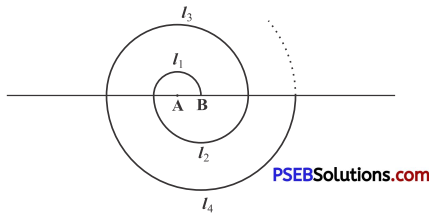


![]()

